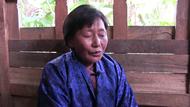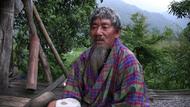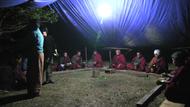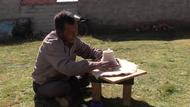Video Overview
Interviewee Bio: Gyeltshen Tulku Rinpoche
Gyeltshen Tulku Rinpoche holds numerous spiritual and practical duties and pursues many activities in that center. Even before that he has effectively supported the strengthening of the Dharma in East Bhutan as an appointed retreat master of the Bhutanese government: he set up nine retreat centers. Besides that he built sanctuaries and more than 100 houses for practitioners of Buddhism, he trained and guided about the same number of Buddhists in the monasteries and centers in his whole country, as himself had been trained, guided and blessed by five enlightened spiritual masters. He always and successfully championed equal treatment and opportunities for nuns and monks in terms of H.H. and the Drukpa order.
For instance in the Jasharung nunnery in Pema Gatshel/Bhutan, which he is leading since 1992, by now almost 50 nuns are living, about 15 of whom have finished their 3-years retreat in 2002. Under the guidance of H.E. Gyeltshen Tulku Rinpoche within only 15 years the infrastructure of the retreat center was improved in many ways to the benefit of all nuns who live there: among others improvements an access road and a system to provide safe drinking water were built as well as electricity and a telephone connection installed.
- MariaRinpoché, it is very nice to see you here, and um… are very happy you agreed to give this interview, and could you please introduce yourself and a bit about…em…about your monasteries in eastern Bhutan and about your monks and nuns, and retreat centers?
- ཨན་སྒྲི་རའེ། (Andrzej)དང་པོ་ཉིད་ནས་མོ་རང་གིས་ཐུགས་རྗེ་ཆེ་རིན་པོ་ཆེ་ལ། དེ་ནང་བཞིན་གིས་མིས་ཀྲིན་(meeting)ཕེབས་ཡ་ལ་རྦད་མི་ཚད་པས་བཀའ་དྲིན་ཆེ། ཐུགས་རྗེ་ཆེ་ཞུས་ཡ་ཡིན། དེ་ནས་རིན་པོ་ཆེའི་དུས་ཚོད་དེ་ཞེ་དྲག་མང་པོ་ཡོད་བ་མ་རེད་བ། མ་གཞི་ནས་དུས་ཚོད་དཀོན་པོ་འདུག ཡིན་ནའང་། དེ་རིང་རིན་པོ་ཆེ་ཕེབས་འདུག རྦད་མི་ཚད་ཐུགས་རྗེ་ཆེ། སྔོན་མ་ནས་མོ་རང་གིས་རིན་པོ་ཆེའི་ལོ་རྒྱུས་མོ་རང་ཧ་གོ་ཚར་བ་རེད། ཡིན་ནའང་། ཧ་མི་གོ་མཁན་དེ་ཚོ་ལ་རིན་པོ་ཆེས་ངོ་སྤྲོད་མདོར་བསྡུས་ཙམ་གསུངས་ན་ལ། རང་གི་ངོ་སྤྲོད། དེ་ནས་རང་གི་མཛད་པ་འཕྲིན་ལས་ཀྱི་སྐོར་ལ་འབྲུག་ཤར་ཕྱོགས་ཀྱི་སྒྲུབ་རྟེན། ཨ་ནེ་དེ་ཚོའི་སྐོར་ལ་གསུངས་ན། དེ་ནས་རང་གི་སློབ་མ། དགེ་སློང་། ཨ་ནེ་དེ་ཚོའི་སྐོར་ལ་དིས་སི་གསུངས་ན་ལ།
- རྒྱལ་མཚན་རིན་པོ་ཆེ།ད་ལྟ། ད་ང་རང་། འ་ད་དེ་ནས་ང་རང་གི་ཕ་ཡུལ་འདྲ་བོ་དེའང་འབྲུག་ཤར་ཕྱོགས་ལ་རེད། དེ་ནས་དེ་ཡིན་དུས་སྐུ་གོང་མའི་གདན་ས་དེའང་འབྲུག་ཤར་ཕྱོགས་ལ་རེད། ད་ང་རང་སྐྱེས་ས་དེའང་ཕ་ཕ་ཨ་མ་དེ་ཚོའང་འབྲུག་ཤར་ཕྱོགས་དེ་བ་རེད། དེ་ནས་ང་རང་སློབ་སྦྱོང་བྱེད་ས་དེ་རྒྱ་གར་རེད། འབྲུག་ཤར་ནུབ་ཕྱོགས་རེད། ག་སར་ག་ལ་མང་པོ་འགྲོ་བསྡད་དགོ་ཀི་རེད། ཡིན་ན་ཡང་། ད་ང་རང་གིས་ཅིག འོ་ད་ཕལ་ཆེར་ལོ་སུམ་ཅུ་སོ་གྲངས་ནས། ད་ཅིག གང་ཟེར་དགོ་ཀི་རེད། ད་ཆོས་བྱས་པའི་བྱ་བ་དེ་ཟེར་གི་ཡོད་བ་རེད། དེ་གའི་ལས་ཀ་བྱེད་ས་དེ་འདྲ་བོ་དེ་གནས་ཆེན་དགོན་པ་འཇམ་དབྱངས། སྒྲུབ་སྡེ་བཙུག་ཡ། བཤད་གྲྭ་བཙུགས་ཡ། སློབ་གྲྭ་བཙུགས་ཡ། དེ་ཚོ་གཙོ་བོ་དེ་ཤར་ཕྱོགས་ལ། རྫོང་ཁག་ལྔ་ཡོད་བ་རེད། འདི་ཚོའི་ནང་ལ་བྱས་བསྡད་ཡོད་བ་རེད། ད་འདིའི་ལས་ཀ་དེ་བྱས་ནས་ད་ཕལ་ཆེར་ལོ་སུམ་ཅུ་སོ་བདུན་ཙམ་ཞིག་འགྲོ་གི་ཡོད་བ་རེད། འོ་དེ་འདྲ་རེད། འུ་ནས་འདིའི་ནང་ལ། ད་ལྟ། ད་སྤྱི་ནས་གྲྭ་ལས་གི་གྲྭ་ཚང་། དེ་ནས་བཤད་གྲྭ། སློབ་གྲྭ། སྒྲུབ་གྲྭ། དེ་ནས་ཨ་ནེ་གི་སློབ་གྲྭ། གྲྭ་ཚང་། འབྲུག་སྡེ། འོ་དེ་འདྲ་ཡོད། འུ་ནས་ཕོ་མོ་གཉིས་ཀའི་འོ་ཁོ་རང་། འོ་ཞབས་ཞུ་ཞུས་ནས་ཁོ་ཚོ་གི་སྡོད་སའི་ཁང་པ། ཟ་ཡ་ཁ་ལག དེ་ནས་སློབ་སྦྱོང་སྤྲོད་མཁན་གྱི་དགེ་རྒན། དེ་ཚོ་བཙུགས་ནས་ད་ངས་དེ་འདྲ་བྱས་ནས། དེ་ནས་ཕལ་ཆེར། ད་ཕལ་ཆེར་ཡར་མར་གཞུང་དང་སྒེར་དང་གང་ག་བསྡོམས་ནས་ཕལ་ཆེར་མི་ཉིས་བརྒྱ་ཙམ་བདག་པོ་བྱས་ནས་བསྡད་སྡོད་ཡོད་ཟེར། འོ་དེ་འདྲ་ཡིན་ད།
- ཨན་སྒྲི་རའེ། (Andrzej)ལགས་སོ། ལགས་སོ།
- AndrzejMe, myself, um.. my place of birth is in eastern Bhutan, and um, so is the place of my predecessor - my previous reincarnation and his seat. My parents as well, my father and mother, are from the east. And although I studied in many different places including India, Bhutan and other places, since thirty-six or thirty-seven years I have been devoting my energy, my time to building monasteries, places of meditative retreat, places of higher learning like shedras (བཤད་གྲྭ) as well as basic education like lopdras (སློབ་གྲྭ།). And all those activities have been happening in the five Eastern Dzongkhags. Since the last thirty-seven years or so, my activities like I said are mainly establishing those centers and supporting them, both monastic centers as well as centers of learning, higher learning, centers of practice for both male and female practitioners. I provide them with sustenance, with food, with lodging, as well as provide the teachers for them. I do it both on the private level as well as with some assistance from the government.
- རྒྱལ་མཚན་རིན་པོ་ཆེ།ལྷག་པར་དུ། དེ་ནས་ང་རང་ཚོ་འབྲུག་རྒྱལ་ཁབ་ནང་ན་རྫོང་ཁག་ཉི་ཤུ་ཡོད་བ་རེད། རྫོང་ཁག་ཉི་ཤུའི་ནང་ལ། དེ་ནས་སྒྲུབ་གྲྭ་དང་། སྒྲུབ་གྲྭ་བ་དེ་ཚོ་སློབ་སྦྱོང་བྱེད་ས་དང་། དེ་ནས་བཤད་གྲྭ་གི་མཐར་ཐུག་སློབ་སྦྱོང་བྱེད་ས་སྔགས་གྲྭ་ཟེར། སྔགས་གི་གཞུང་དེ་འདྲ་སློབ་སྦྱོང་བྱེད་ས་འདྲ་བོ་དེ་སྔོན་མ་མི་འདུག དེ་ནས་ངས་གཞི་བཙུགས་བྱས་ནས་ད་ཕལ་ཆེར། མོང་སྒར་ལ་གཞི་བཙུགས་བྱས་ནས་ད་ཕལ་ཆེར་ལོ་བཅོ་ལྔ་ཙམ་ཞིག་འགྲོ་གིན་ཡོད། འདིའི་ནང་ལ། སློབ་གྲྭ་གང་ཟེར་དགོ་ཀི་རེད། སྒྲུབ་གྲྭ་མ་འགྲོ་བའི་སྔོན་ལ། དེ་ནས་མར་དེ་གའི་ནང་ལ་ལོ་བདུན་བརྒྱད་ལ་སློབ་སྦྱོད་བྱེད་ཀྱི་ཡོད་རེད། སྔགས་དེ་སློབ་སྦྱོང་བྱས་ཚར་ནས་གཞི་ནས་སྒྲུབ་གྲྭ་ནང་ལ་འགྲོ་གི་ཡོད་བ་རེད། སྒྲུབ་གྲྭ་ནང་ལའང་དེ་ནས་ལོ་གསུམ། ལོ་དྲུག ལོ་དགུ དེ་ནས་ཡར་འགྲོ་མཁན་དེ་ཚོ་རི་ཁྲོད་སྒང་ལ་འགྲོ་གི་ཡོད་ཟེར། དེ་འདྲས་བྱས་ནས་འགྲོ་བསྡད་ཀིན་ཡོད།
- ཨན་སྒྲི་རའེ། (Andrzej)ལགས་སོ།
- AndrzejThe, the establishments such as I managed to start such as drupdra the organized places for retreat, for solitary retreat, as well as shedra, and especially ngakdra (སྔགས་གྲྭ།), the places where in a mm… systematic manner the practice and theory of Mantrayana is taught were not existent before I actually established them, before I started them for the first time fifteen years ago in, in Monggar. Now those are functioning, they do exist. The system, the way the practitioner enters the system is that first they would study for a period of seven or eight years or more and only then move on to what we call drupdra, retreat center and there they will spend from three to six to even nine years in systematic practice in a group. Then, however many of them would continue their personal practice alone in places we call ritrö (རི་ཁྲོད།) or gangtrö (སྒང་ཁྲོད), places where they would practice alone
- MariaMhmm
- Andrzejmountain retreats.
- MariaAnd, um….Rinpoché, can you tell us a bit about Vajrayana practices? What..What is the origin of Vajrayana practice? And maybe how different Vajrayana practices are from other practices? Because here in the West, we don’t know a lot about Vajrayana. We know mostly about mindfulness and about samatha and about vipassana a bit. But many people don’t even understand what actual Vajrayana practices is, where it is coming from and how is it different from meditative practices of other traditions
- ཨན་སྒྲི་རའེ། (Andrzej)Okay.
- ཨན་སྒྲི་རའེ། (Andrzej)དེ་ནས་ད་ལྟ་རིན་པོ་ཆེ་གིས་ཨ་ནེ། ང་ཚོ་གསང་སྔགས་རྡོ་རྗེ་ཐེག་པའི་སྐོར་ལ་དིས་སི་འདྲ་བོ་ཞིག་གསུངས་ན། དཔེར་ན། དེ་ནས་ང་ཚོ་སྤྱིར་བཏང་གི་ཚད་ཉིད་ཐེག་པ། མདོ་ཚད་ཉིད་ཐེག་པ་དང་གསང་སྔགས་རྡོ་རྗེ་ཐེག་པའི་ཁྱད་པར་གྱི་སྐོར་ལ་དིས་སི་ཞིག་གསུངས་ན། ང་ཚོ་ཀིས་ ནུབ་ཕྱོགས་པ་མང་ཆེ་བ་ཀིས་ཕལ་ཆེར་སྒོམ་ཉམས་ལེན། ག་རེ་རེད་ཟེར་ན། ད་སྒྲིམ་པ། ད་སྒྲིམ་པ་དང་་་་་གསུངས་ཡ་ད་གཅིག་པོ། དཔེར་ན། ཞི་གནས་སྒོམ་ཡ་ནང་བཞིན། ལྷག་མཐོང་སྒོམ་ཡ་ནང་བཞིན་དེ་གཅིག་པོ་རེད་བསམ་གིན་འདུག དེ་ནས་གསང་སྔགས་ཀི་ཁྱད་ཆོས་དེ་ གསལ་བོ་ཞེ་དྲག་ཞེ་དྲག་ཧ་གོ་ཀི་ཡོད་པ་མ་རེད། འོ་དེ་ཡིན་ཙང་། རིན་པོ་ཆེ་ཀིས་དིས་སི་གསང་སྔགས་ཀི་ཁྱད་ཆོས་འདྲ་བོ་ཞིག་གསུངས་ན་ལགས།
- རྒྱལ་མཚན་རིན་པོ་ཆེ།འོ་ལགས་སོ། དེ་ནས། འོ་རེད། ད་སྤྱིར་བཏང་སྒོམ་རྒྱག་ཡ་དེ་ལ་མདོ་ཚད་ཉིད་ཐེག་པ་ལའང་སྒོམ་རྒྱག་ཡ་ཡོད་བ་རེད། མདོ་ནང་ལ་བྱས་པ་ཡིན་ན། ཉན་ཐོས་དེ་ཚོའི་རིགས་ལའང་དེ་ནས་སྒོམ་རྒྱག་ཡ་ཡོད་བ་རེད། ཐེག་ཆེན་ལའང་སྒོམ་རྒྱག་ཡ་ཡོད་བ་རེད། གཉིས་ཀ་ལ་སྒོམ་རྒྱག་ཡ་ཡོད་བ་རེད། དེ་ཡིན་ན་ཡང་། ད་དེ་ནས་ཁོ་རང་ལྟ་བའི་ཁྱད་པར། སྒོམ་པའི་ཁྱད་པར། སྤྱོད་པའི་ཁྱད་པར་དེ་ཚོ་ཡོད་བ་རེད། དེ་ནས་ད་ཡིན་ན་ཡང་། ཞི་གནས་དེ་ཚོ་གཅིག་པ་རེད། ཞི་གནས་དང་ལྷག་མཐོང་དང་དེ་ཚོ་སྒོམ་གིན་ཡོད་བ་རེད། དེ་ནས་ད་ཞི་གནས་ལྷག་མཐོང་འདིའི་སེམས་བསྐྱེད་འགྲོ་སྟངས་འདིའི་ཐོག་ནས་གཙོ་བོ། དེ་ནས་གསང་སྔགས་ནང་ལ་ག་རེ་འགྲོ་ཡི་ཡོད་ཟེར་ན། དེ་ནས་ཞི་གནས་ལྷག་མཐོང་མཉམ་པོར་དེ་གསང་སྔགས་ནང་ལ་བསྐྱེད་རིམ་དང་རྫོགས་རིམ་ཞེས་པ་དེ་གཉིས་ལ་འགྲོ་ཡི་ཡོད་བ་རེད།
- ཨན་སྒྲི་རའེ། (Andrzej)འུམ། ལགས་སོ།།
- རྒྱལ་མཚན་རིན་པོ་ཆེ།དེ་ནས་བསྐྱེད་རིམ་དང་རྫོགས་རིམ་དེ་སྦྱར་ཡོང་ནས་དེ་ནས་ཞི་གནས་ཀི་དེ་ལ་བརྟེན་ནས། འོ། འུམ། མུག་པ་འདྲ་བོས་ཕོགས་འགྲོ་ཡ་འདྲ་བོ་དང་། ནུས་པ་ཐོན་ཡ་འདྲ་བོ། དེ་ནུས་པ་དེ་མགྱོགས་པོར་ཐོན་ཡ་འབྲས་བུ། འབྲས་བུ་མགྱོགས་པོ་ཡོང་ཡ། འགྲུབ་ཡ་ཆེད་དུ་ལ། དེ་ནས་སྔགས་ཀི་བསྐྱེད་རིམ། དེ་ནས་འོ་ད་བསྐྱེད་རིམ་དེ་ཚོ་ཐོས་བསམ་སྒོམ་གསུམ་ཞིག་ཡོད་བ་རེད། དེ་ནས་འོ་ཤེས་རབ་རྫོགས་པའི་རིམ་པ། དེ་ནས་རྫོགས་རིམ་དེ་ཚོ་ལྷག་མཐོང་གཙོ་བོ་ནུས་པ་འཕར་ཡ་ཆེད་དུ་ལ། རྨི་ལམ་ཡིན་པ་རེད། དེ་ཡིན་ཙང་དེ་ནས་རྫོགས་རིམ་གྱི་སྐོར་མང་པོ་ཞིག་ཡོད་བ་རེད། དེ་ནས་རྫོགས་རིམ་དེ་ལ་ བརྟེན་ནས་སྤྱིར་བཏང་གིས་ལྷག་མཐོང་སྒོམ་པ་དེ་དེའི་ཐོག་ནས་རྫོགས་རམ་དང་སྦྱར་ནས་སྒོམ་ན། འུ་ནས་ནུས་པ་ཆེན་པོ་ཡོང་གི་ཡོད་བ་རེད། དེ་ཡིན་ ཙང་། དེ་ནས་ཅིག་རྫོགས་རིམ་དེ་ལ། འོ་ད་ཅི་ཟེར་དགོ་ཀི་རེད། དེ་ནས་ཅིག་མདོ་ནང་ལ་མེད་པའི་དེ་ནས་ཚིག་བརྗོད་མང་པོ་ཞིག་ཡོད་བ་རེད། བསྐྱེད་རིམ་ཡིན་ན་ཡང་། མདོ་ནང་ལ་མེད་པའི་ཁྱད་ཆོས་མང་པོ་ཞིག་ཡོད་བ་རེད། དེ་ཡིན་ཙང་། དེ་ནས་ཞི་གནས་ལྷག་མཐོང་གི་གཞི་དེའི་ཐོག་ལ་དེ་ནས་ ཐབས་དང་སྦྱར་ཡོང་དུས་དེ་གསང་སྔགས་ཆགས་འགྲོ་ཡི་ཡོད་བ་རེད། དེ་ནས་མདོ་ལས་ཀྱང་ཐབས་ཕུལ་དུ་ཕྱིན་པ་དེ་འདྲ་ཞིག་ལ་གསང་སྔགས་ཡོད་ བ་རེད། དེ་ཡིན་ཙང་། དེ་ནས་འོ་སྤྱི་དང་སྤྱིར་བཏང་དེ་འདྲ་རེད། ལྷག་པར་དུ་འབྲུག་པ་བཀའ་བརྒྱུད་པ་ལ་མཚོན་པ་ཡིན་ན།
- དེ་ནས་གསང་སྔགས་ཀི་སྒོམ་ཉམས་ལེན་བྱེད་ཡ་ལ། དེ་ནས་བསྐྱེད་རིམ་ལྷ་དགུ་ཟེར་ཡ་འདྲ་བོ་དང་། རྫོགས་རིམ་དང་པོ་ལྔ་ཟེར་ཡ་འདྲ་བོ་དེ་འདྲས་ཡོད་བ་རེད། འོ་དེ་ཚོ་དེ་ཁོ་རང་རེ་རེ་རེ་རེ་ལ་དེ་ནས་མུན་པ་བསྐྱེད་པའི་དབང་། འགྲོ་བསྐྱེད་ཀྱི་འཁྲིས། སྨྲེ་སྔགས་ཀི་ལག་ལེན་དེ་ཚོ་ཁོ་རང་ཚད་དང་ལྡན་པ་ཞིག་ཟླ་བ་དྲུག་ཡིན་ན་ཟླ་བ་དྲུག་ལ་འགྲོ་དགོ་བ། བདུན་ཡིན་ན་བདུན་འགྲོ་དགོ་བ། དེ་འདྲས་འདྲ་བོ་ཞིག དེ་ནས་ཟླ་བ་གཅིག་ནས་དེ་ནས་ཟླ་བ་བདུན་བློ་བརྒྱུད་བར་དུ་དེ་ནས་ཚེ་གང་བརྒྱུད་ནས་སངས་རྒྱས་ཀྱིས་དེ་ནས་ངག་ཕྱོགས་ནས་གང་གསུངས་པ་ལྟར་དུ། དེ་ནས་ཅིག་ལག་ལེན་འདྲ་བོ་དེ་ཚད་དང་ལྡན་པ་ཞིག་ཡོད་བ་རེད། ད་དེ་ཚོ་ལ་ཁོ་རང་ཚོ་ལ་མ་ཉམས་པ། རྒྱུན་འཁྱོངས། འོ་དེ་བྱས་ནས་བསྡད་ཡོད་བ་རེད་ཟེར།
- ཨན་སྒྲི་རའེ། (Andrzej)ལགས་སོ།།
- AndrzejThere is a…um…the… both the tradition of Sutrayana, that is what we call the vehicle of characteristics, as well as the mantra vehicle, ah… both in the traditional of Sutrayana, both the sravaka level, or as we call it Hinayana, and the Mahayana possess both the practices of mindfulness, samatha, vipassana, and so on. And those have, those different vehicles, right? Within the Sutrayana, as well as the Mantrayana itself possess their individual way of looking at things that we call the view. They also have different ways of accustoming oneself, accustoming the practitioner with the view, that’s meditation. And they also have different modes of behavior that we call the action. But samatha and vipassana exist both in Sutrayana and Mantrayana. Samatha and vipassana in fact are very essential. They are the basis for the practice of Mantrayana as well. However, in the Mantrayana they are very much intimately linked with the practices of kyerim (བསྐྱེད་རིམ), the generation stage, and dzokrim (རྫོགས་རིམ།), the completion stage. kyerim corresponds with to the practice of Samatha in the way that if kyerim is done being rooted in Samatha, the practice of calm abiding, that brings about progress on the path of kyerim much faster, its potency is enhanced, and the results can be achieved much, much sooner.
- AndrzejSo, on the practice of Mantrayana we have the individual, we have differences based on the view, meditation, and action however samatha is present. When it comes to vipassana, it’s closely linked to, or the practice of higher insight, it is closely linked to the dzokrim practice. Dzokrim - meaning completion stages. There are many different cycles of dzokrim practice and they are enhanced, they are improved with the practice of vipassana. So, what you could say is, the Sutrayana style meditation both samatha and vipassana is, becomes the Mantrayana practice if you apply what we call skillful means, tap (ཐབས) or upaya. Um…There are many different ways in which you can meditate in Mantrayana generally, but especially in the school of the Drukpa Kagyü (འབྲུག་པ་བཀའ་བརྒྱུད།) we have the practices of the generation stage with the deities as well as the completion stage both the characteristic ones and the characteristic-less ones. And those have to be properly studied and applied. We have a system where you would trust receive the empowerment to bring about the maturity of the mind, then one would properly receive the instructions, the pith instructions that bring about the liberation of the mind, and the liberation of mind – freedom, and then also apply what we call the pith instructions, crucial instructions. This takes around six months to complete, to receive the teachings, and then apply to them in practice sometimes up to seven months or even twelve months one will be receiving and trying to apply those in, you know, in one’s own practice.
- རྒྱལ་མཚན་རིན་པོ་ཆེ།འོ་ཡ། དེ་ནས། ད་གའི་ངས་སྐད་ཆ་བཤད་ཡ་དེ་ལྷག་འགྱོ་ལྷག་ཡ་དེ་ལྷག་འདུག ད་དེ་མདོ་སྔགས་སྐོར་གྱི་ཁྱད་པར་བཤད་ན་མང་པོ་ཡོད་བ་རེད། ཚུར་མདོར་བསྡུས་ན། ད་གའི་མང་པོ་བཤད་པ་དེ་ཚུར་མདོར་བསྡུས་ན། དེ་ནས་རྒྱུད་ཁོ་རང་ནང་ལ་གསུངས་བཞག་པ་དེ། དེ་ནས་མདོ་དང་སྔགས་ཀི་ཁྱད་པར་དེ། དོན་གཅིག་ན་ཡང་མ་རྨོངས་པ་དང་།། ཐབས་མང་དཀའ་བ་མེད་པ་དང་།། དབང་པོ་རྣོན་པོའི་དབང་བྱས་ནས།། སྔགས་ཀྱི་ཐེག་པ་ཁྱད་པར་འཕགས།། ཁྱད་པར་བཞི་ན་ཅིག་གིས་མདོ་སྔགས་ཀྱི་ཤེས་རབ་འཕགས་ཡིན་ཟེར་ནས་གཞུང་ཁོ་རང་ནང་ལ་དེ་འདྲ་ཡོད་བ་རེད་ཟེར།
- ཨན་སྒྲི་རའེ། (Andrzej)འོ་ལགས་སོ།།
- AndrzejGenerally, to put it very briefly the difference between the Sutrayana and the Mantrayana as mentioned in the Tantras is that, there is less, there is more methods and less hardship, it is for those of the superior faculty and it is much faster, the Mantrayana vehicle. That’s what differentiates it from the Sutrayana.
- MariaAnd, in terms of their origin, because, are they the same origin? Or Vajrayana practices also have their origin in India?
- AndrzejMhmm
- ཨན་སྒྲི་རའེ། (Andrzej)དེ་ནས་འུ་ནས་གསང་སྔགས་ཀྱི་འབྱུང་ས་སྐོར་ནས་དིས་སི་འདྲ་བོ་ཅིག་གསུངས་ན། དཔེར་ན། ཚང་མ་རྒྱ་གར་ནས་ཡོང་ཡིན་པ། ག་འདྲ་ཡིན་པ། ཁོ་རང་གི་འབྱུང་ཁུངས། འབྱུང་ས་དེ།
- རྒྱལ་མཚན་རིན་པོ་ཆེ།རེད་རེད། གསང་སྔགས་ཀྱི་འབྱུང་ཁུངས་བཤད་སྟངས་དེ་ག་བ་ཡིན་ན་དེ། འབྱུང་ས་དེ། སྤྱིར་བཏང་གི་སངས་རྒྱས་ཆོས་ཀྱི་འབྱུང་ཁུངས་དེ་རྒྱ་གར་ཡིན་པ་རེད། ཡིན་ན་ཡང་། ད་ལྟ་ཁ་ཤས་ནི་ཕར་ནུབ་ཕྱོགས་ཅན་གྱི་ཡུལ་ནས་ཚུར་སྤྱན་དྲངས་པ་དེ་འདྲ་ཡོད་པ་རེད། གསང་སྔགས་ཀིས་དེ་ཚོ། ནུབ་ཕྱོགས་ཅན་དེ་དེང་སང་གི་ཨ་ཧྥུ་ཀ་ནི་སི་ཐན་དེ་འདྲ་ཅིག་ལ་རེད་ཟེར་གིན་འདུག་གཱ ནུབ་ཕྱོགས་ཅན་གྱི་ཡུལ་ལ་དེ་ནས་རྡོ་རྗེ་ཕག་མོ་གི་ཕོ་བྲང་། ཁོ་རང་བཞུགས་ས་དེ་འདྲ་ཡོད་བ་རེད་ཟེར་ནས་ལོ་རྒྱུས་ཡོད་བ་རེད། འོ་ད་དེ་ནས་ད་ཚུར། དེ་ནས་ཅིག་མགོན་པོ་ཀླུ་སྒྲུབ་ལ་སོགས་པའི་གསང་སྔགས་ཀྱི་གཞུང་དེ་ཚོ་གདན་འདྲེན་ནས་སྤྱན་དྲངས་པའི་ལོ་རྒྱུས་ཡོད་པ་རེད། འུ་ནས། སྤྱིར་བཏང་གི་ལོ་རྒྱུས་དེ་འདྲ་རེད། དེ་ནས་ཡང་། དམིགས་བསལ་གྱིས་ད་ལྟ་བཀའ་བརྒྱུད་པའི་ལོ་རྒྱུས་འདྲ་བོ་བཤད་པ་ཡིན་ན། དེ་ནས་ཏེ་ལོ་པ་གྲུབ་ཆེན་བརྒྱད་ཅུ་རྩ་བཞིའི་ནང་ནས་གྲུབ་ཆེན་ཏེ་ལོ་པ་ཟེར་བ་དེ་ཡིས། སྤྱིར་བཏང་གིས་ཁོ་རང་གིས་ཐུན་མོང་མིན་ངོག་ལ་སྐབས་བབ་ཀྱི་བླ་མ་ཞིག་ལ་བརྟེན་ནས། དེ་ནས་སྐབས་བབ་ཀྱི་གདམས་ངག་ལ་ཞུགས་ཡོད་པ་རེད། འུ་ནས། ཐུན་མོང་མ་ཡིན་པ་དེ་ང་ལ་ངའི་བླ་མ་མིན། ང་ཡི་བླ་མ་ཐམས་ཅན་མཁྱེན་གཞལ་གསུང་བ་ལྟར་དུ་བྱས་ནས། འུ་ནས་ཁོ་རང་གྲུབ་པ་ཐོབ་ནས། དེ་ནས་རྫུ་འཕྲུལ་གྱི་མངོན་སུམ་དུ་བདག་པོའི་ཞིམ་ཁམས། འོད་མེད་ཆོས་ཀྱི་སྙིང་ཁམས་ཆོས་ཀྱི་ཞིང་ཁམས།
- རྒྱལ་མཚན་རིན་པོ་ཆེ།དེ་ནས་ད་རྡོ་རྗེ་འཆང་གི་སྐུ་མདུན་ལ་དེ་ནས་མིའི་དང་མིའི་བདག་པོ་ལྟ་བུ། དེ་ནས་རྡོ་རྗེ་འཆང་གི་སྐུ་མདུན་ནས་རྒྱལ་བ་དགོངས་བརྒྱུད་ཀྱི་བརྒྱུད་པ། དེ་ནས་ག་རེ་ཟེར་དགོ་རེད། རྫོགས་རིམ་གྱི་གནད་འགག་དེ་དག་གང་ག་ཕ་རྒྱུད། མ་རྒྱུད། གཉིས་མེད་ཀྱི་རྒྱུད། བླ་ན་མེད་པའི་རྒྱུད་དེ་དག་གང་ག་འདིའི་ནང་དུ་ཚུད་འགྲོ་གིན་ཡོད་བ་རེད། དེ་ཚོ་གང་ག་རྫོགས་རིམ་གྱི་གནས་དེ་ཚོ་དེ་ནས་རྡོ་རྗེ་འཆང་གི་སྐུ་མདུན་ནས་ཏེ་ལོ་པ་ཡིས་སན་པ་རེད། ཏེ་ལོ་པ་ཡིས་སན་ནས་དེ་ནས་རྒྱལ་བ་དགོངས་བརྒྱུད་ཚུལ་དུ་སན་ནས། དེ་ནས་སླར་ཡང་འཇིག་རྟེན་མི་ཡུལ་རྒྱ་གར་ལ་ཕེབས་ནས་དེ་ནས་སློབ་མ་མང་པོ་ཡོད་བ་རེད་དེ། ཆ་ཚང་གནང་ཡ་ནཱ་རོ་པ་སྟེ། པཎ་ཆེན་ནཱ་རོ་པ་ལ་གནང་པ་རེད། ནཱ་རོ་པ་དེ་ནས་ཡར་བོད་ལ་བརྒྱུད། བོད་ནས་དེ་ནས་ང་ཚོ་འབྲུག་ལ་ཆོས་བརྒྱུད་དེ་ཚོ་གང་དག་བོད་ནས་འབྱུང་བ་ཤ་སྟག་རེད། རྒྱ་གར་ནས་ཤར་རྒྱག་དེ་འདྲ་སླེབས་ཡོད་པ་མ་རེད། རྩ་བའི་བླ་མ་བརྒྱུད་པ་དེ་ཚོ་དེ་ནས་བརྒྱུད་པ་དེ་ཚོ་དེ་འདྲ་རེད་ཟེར།
- ཨན་སྒྲི་རའེ། (Andrzej)ལགས་སོ།།
- AndrzejWhen we speak about the origin of Mantrayana, generally speaking, the Buddhist teachings, they all originate in India. However, some of the Mantrayana teachings do find their origin in the northern land of Urgyen, or as we know it nowadays it is a geographic area somewhere around Afghanistan and there are stories of the existence of Vajravarahi’s palace there. And there’s some dharma, teachings of Mantrayana that originate there, not in India. There are also stories of the master Nagarjuna bringing some of the Mantrayana teachings into the human world. Generally, that’s a general approach. Now when it comes to particular Kagyü (བཀའ་བརྒྱུད།) school, particulars of the Kagyü school’s origin amongst the eighty-four great awakened masters of India, the eighty-four mahasiddhas as we call them, one of them was Tilopa (ཏེ་ལོ་པ།) who although received the ordinary transmissions from human teachers, he received the extraordinary transmissions without the aid of a human master.
- AndrzejIt is said that once he got realized himself, he was able to magically travel to places such as even the highest pure realm, we called Akanishtha - nothing is higher than that. Their from the master, no human master, from the dharmakaya, Master Vajradhara, the vajra holder, he received all of the teachings in a manner of mind-download, that happens only between the Buddhas. We call it gyelwa gonggyü (རྒྱལ་བ་དགོངས་བརྒྱུད།) or the Victor’s mind lineage, where the Father tantras, Mother tantras, Non-Dual Tantras, and the Unsurpassable Tantras were transferred. All of the teachings, all of the crucial points of the dzokrim, completion stages, happened in this way from Tilopa directly, ah..to Tilopa directly from Vajradhara. Although Tilopa had many disciples, the one that he conferred all the totality of the teachings he himself received was Naropa alone. Naropa, the pandita, the great pandita, the great scholar Naropa, who then later helped the teachings, helped the spread of the teachings in Tibet. This is how the Dharma lineage looks like.
- MariaMm… Rinpoché mentioned generation stages and completion stages, so, can you ask about, you know all these stages and also we have completion with sign or Six Yogas of Naropa practice, can the Rinpoché about those, and
- AndrzejSure.
- Mariaactually how these are done in training?
- AndrzejWould you like me to also ask about their purpose, or?
- MariaYes, is it even correct to say that these practices, you know, they target transformation of mind and body and if possible to ask generation stages, why generation stages? And what is the goal of the completion stages with signs as well?
- AndrzejMhmm… ལགས་སོ།
- ཨན་སྒྲི་རའེ། (Andrzej)དེ་ནས་རིན་པོ་ཆེ་ཡིས་བསྐྱེད་རིམ་དང་རྫོགས་རིམ་གྱི་སྐོར་ལ་དིས་སི་གསུངས་སོང་ང་། ད་ང་ཚོ་བསྐྱེད་རིམ་དང་རྫོགས་རིམ་སྤྱིར་བཏང་ཁོང་གི་མཚན་ཉིད་འདྲ་བོ། ཁོ་རང་གིས། འུ་ནས་ག་རེ་ཟེར་དགོ་ཀི་རེད། ཁོ་རང་གི་དོན་དག་མདོར་བསྡུས་འདྲ་བོ་ཞིག་གསུངས་ན། གཅིག་དེ་ཁོང་གི་དགོས་པ་འདྲ་བོ། ག་རེ་བྱས་ནས་ང་རང་ཚོས་བསྐྱེད་རིམ་དང་རྫོགས་རིམ་སྒོམ་གིན་ཡོད། མོ་རང་གིས་དམིགས་བསལ་གྱི་དོ་སྣང་དེ་ཕལ་ཆེར་སེམས་བསྐྱེད། སེམས་བསྐྱེད་ཀྱི་རྫོགས་རིམ་ལ་འགྲོ་གིན་ཡོད་ས་རེད། ཁོ་རང་མོ་རང་གིས་སེམས་བསྐྱེད་དེ། མོ་རང་གི་ས་ཞིབ་གསལ་བྱེད་ཀིན་འདུག་གཱ ཞིབ་གསལ་དེ་ཕལ་ཆེར་སེམས་བསྐྱེད་ཀྱི་རྫོགས་རིམ་ལ་བཏང་ཡོད་རྒྱུ་རེད། འུ་ནས་དེའི་སྐོར་ལ་དིས་སི་འདྲ་བོ་གསུངས་ན་ལ། ང་རང་ཚོས་སེམས་བསྐྱེད་རྫོགས་རིམ་མཇལ་ཡོང་དུས་ང་རང་ཚོའི་ལུས་གང་འདྲ་སུ་འགྱུར་འགྲོ་གི་རེད། ང་ཚོ་གི་སེམས་གང་འདྲ་སུ་འགྱུར་འགྲོ་གི་རེད་ཅིག་གསུངས་ན་ལ།
- རྒྱལ་མཚན་རིན་པོ་ཆེ།འོ། ལགས་སོ།། ད་དེ་ནས་བསྐྱེད་རིམ་ཟེར་ཡ་དེ། དོན་དག་ངོ་མ་དེ་ག་རེ་རེད་ཟེར་ན། བསྐྱེད་རིམ་ཟེར་ཡ་དེ་ཕྱིའི་གནོད་ཀྱི་འཇིག་རྟེན། འབྱུང་བ་བཞི། གནམ་ཁ་དང་བཅས་པ་འབྱུང་བ་ལྔ། དེ་ནས་རང་གི་ལུས། ཕུང་པོ་ལྔ་ལས་གྲུབ་པའི་ལུས། སྣོད་བཅུད་སྔོན་འགོག་དེ་ད་ལྟ་ང་རང་ཚོ་མི་ཡིན་ན། མི་ལ་སྣོད་བཅུད་སྔོན་འགོག་ཅིག་སྒྲུབ་བསྡད་འདུག་གཱ འོ་དེ་དེ་ཚོ་གང་དག་ལྷ་ཡུལ། དེ་ནས་ཕྱི་སྣོད་ཀྱི་འཇིག་རྟེན། དཀྱིལ་འཁོར། གཞལ་ཡས་ཁང། ནང་གི་ལུས། དེ་ནས་ཕུང་པོ་ལྔ། དེ་ཚོ་གང་ག་དེ་ནས་ལྷ་ལ་འགྲོ་དགོ་ཀི་ཡོད་བ་རེད། ལྷ་ཡུལ་འདུ་འཛིན་དེ་ཚོ་ཕར་སྣང་བ་ལ་བསྒྱུར་དགོ་ཀི་ཡོད་བ་རེད། དེ་ནས་རང་གི་ལུས་ལ་གཅིག་པོ་གཅིག་ལ་ཆ་བཞག་པ་ཡིན་ན། དེ་ནས་ང་རང་ཚོ་ཀི་ད་ལྟ་ལུས་ངག་ཡིད་གསུམ་པོ་སྟེ། ལུས་དེ་དེ་ནས་གནས་ཚུལ་ནང་ལ་ཡོད་པ་དེ་བདེན་པ་ཉིད་ནས་དེ་ནས་ཁོ་རང་ལྷ་ཡིན་ཟེར་ཀི་ཡོད་བ་རེད། ལྷ་ཡི་རང་བཞིན་ཡིན་ཟེར་ཀི་ཡོད་བ་རེད། དེ་ཡིན་ཙང་། དེ་ནས་ལྷ་ཡུལ་རང་བཞིན་ཡིན་པ་དེ་གཏན་པ་འབབས་ནས་ད་ལྷ་བྱས་ནས་སྒོམ་ཡ་དེ། དེ་ནས་འོ་ལུས། ལྷ། ངག སྔགས། སེམས་ཏིང་ངེ་འཛིན་ཟེར། ལུས་ངག་ཡིད་གསུམ་ཀི་དེ་ནས་སེམས་ཅན་ལའང་ལུས་ངག་ཡིད་གསུམ་ཡོད་པ་རེད། ལམ་ལ་གནས་པའི་རྣམ་འགྱུར་པ་ལའང་ལུས་ངག་ཡིད་གསུམ་ཡོད་བ་རེད། སངས་རྒྱས་ལའང་ལུས་ངག་ཡིད་གསུམ་ཡོད་བ་རེད། དེ་ཡིན་ཙང་། སངས་རྒྱས་ལ་སྐུ་གསུང་ཐུགས་ཞུས་ཀིན་ཡོད་བ་རེད། དེ་ནས་སེམས་ཅན་ལའང་ལུས་ངག་ཡིད་གསུམ་ཟེར་གིན་ཡོད་བ་རེད། ད་དེ་ཁོ་རང་གི་རག་པ་དང་ཕྲ་བ་ཟེར་ན་མི་འདུག ཡང་ན། བདག་དང་མ་བདག་དེ་འདྲ་ཅིག་རེད་མ་གཏོགས། འུ་ནས་ད་བསྐྱེད་རིམ་ཟེར་དེ་ཚོ་དེ་ནས་ང་རང་ཚོ་སྡོད་སའི་ས་གནས། འུ་ནས་སྡོད་སའི་ཁང་པ། དེ་ནས་རང་གི་ལུས་དེ་ཚོ། གཟུགས་པོ་དེ་ཚོ་གཟུགས་སུ་གྲུབ་པ་དེ་ཚོ་གང་ག དེ་ནས་ལྷ་དེ་ནས་སྒོམ་འགྲོ་ཀི་ཡོད་བ་རེད། མིང་ལ་བསྐྱེད་རིམ་ཟེར། བསྐྱེད་རིམ་ཟེར་དུས་གཅིག་སྟེ་ཡེ་ཤེས་ཟེར་དུས་སངས་རྒྱས་པའི་མཐར་ཐུག་པའི་ཐུག་དེ་རེད། ཡེ་ཤེས་རིམ་གྱིས་བསྐྱེད་པས་ན་བསྐྱེད་རིམ་ཟེར།
- ཨན་སྒྲི་རའེ། (Andrzej)འོ་ལགས་སོ།
- རྒྱལ་མཚན་རིན་པོ་ཆེ།འོ་གཅིག་ཆད་འདུག དེ་ནས་དེ་དང་འདྲ་བོ། དེ་ནས་རྫོགས་རིམ་དེའི་ནང་ལ་གཙོ་བོ་ག་རེ་བཤད་ཀྱིན་ཡོད་བ་རེད་ཟེར་ན། དེ་ནས་ང་ཚོ་སེམས་ཅན་གྱི་གནས་སྐབས་ཡིན་ན། ངག་དང་ཡིད་ཀྱི་གཙོ་བཤད་པ་རེད། དེ་ནས་ངག་གནས་ཚུལ་དང་ཡིད་ཀྱི་གནས་ཚུལ་དེ་ཚོ་གཙོ་བཤད་ཀྱིན་ཡོད་པ་རེད། དེ་ལ་བརྟེན་ནས་རྫོགས་རིམ་ཟེར་གིན་ཡོད་བ་རེད། རྫོགས་རིམ་དེ་ལའང་གཉིས་ཡོད་བ་རེད། ད་ལྟ་ཅིག་རྩ་རླུང་དེ་ཚོ་སྒོམ་ཡ་དེ་གཙོ་བོ་ངག་གི་གནས་སྟངས་འགྲོ་ཀི་ཡོད་བ་རེད། ད་ཕྱིའི་ལུས་ངག་ཡིད་གསུམ་ཡོད་བ་རེད། ནང་གི་གཟུགས་པོ་དེ་ལ་ཚུར་བསྡུ། ཚུར་བསྡུས་པ་ཡིན་ན། དེ་ནས་རྩ་དང་། རླུང་དང་། ཐིག་ལེ་གསུམ་ལ་ཐུག་འགྲོ་ཀི་ཡོད་བ་རེད། དེ་ནས་ཐིག་ལེ། རྩ་དང་། རླུང་དང་། ཐིག་ལེ་དེ་ཚོ་གསུམ་པོ་དེ་ཡང་ཕར་ཕར་ཅིག་དེ་ནས་གསང་བའི་ནང་ནས་གསང་བ་ཕར་གཏད་པ་ཡིན་ན། འུ་ནས་སྐུ་གསུང་ཐུགས་ལ་དེ་ནས་ཕྲ་བ་དེ་ལ་འགྱུར་འགྲོ་ཀི་རེད། དེ་ཡིན་ཙང་། ཕྲ་བའི་གནས་སྟངས་དེ་སངས་རྒྱས་ཀྱི་རང་བཞིན་ཡིན་གསུངས་པ་རེད། དེ་ཡིན་ཙང་། དེ་ནས་ཐར་བའི་གནས་སྟངས་དེ་ཚོ་ལ་རྫོགས་རིམ་ཟེར་གིན་ཡོད་བ་རེད། འོ་ཡེ་ཤེས་རྫོགས་པར་སྟོན་པས་ན་རྫོགས་རིམ་ཟེར་གིན་ཡོད་བ་རེད། འོ་ད་དེ་འདྲ་འདྲ་བོ་ཞིག་རེད།
- ཨན་སྒྲི་རའེ། (Andrzej)ལགས་སོ་ལགས།
- AndrzejWhen it comes to the kyerim, the practice of generation stage, the view is that all of the outer phenomena, the inanimate world with the four elements, and if you take the element of the sky the five elements, as well as the psychophysical constituents of our body like the five heaps or five skandhas you probably familiar with, they are all seen as divine, as pure. The outer world is seen as the mandala and the pure realms, the palaces of the deities, and our body, the five skandhas, are seen as divine as well. And basically the practice of kyerim aims at realizing that divinity. Ah.. we… if we look at our own being, we are, we consist of the body, the speech, and the mind and we look at our body, speech, and mind from the prism of always having been pure, it’s just that we have not been noticing that.
- AndrzejWe first ascertained that purity and then we practice in accordance with that notion of purity. Ordinary beings have ordinary body, speech, and mind. But in fact, mmm… seen from the correct perspective, they are nothing but divinity or lha (ལྷ།), nothing but the mantra, and nothing but meditative absorption. This is possessed by not only… This is possessed by ordinary beings, this is possessed by practitioners on the path, but also possessed by the Buddhas. And the difference between ordinary beings and yogis on the path and the Buddhas is simply the Buddhas’ aspect is more subtle, whereas the beings have them in a very coarse manner. They experience their own reality in a very coarse manner. The Buddhas’ reality is purified as it is and the beings' reality remains impure, seen through the prism of impure perception. So, kyerim aims at the transformation of this perception of impurity into the pure perception. So, “kye-rim” (བསྐྱེད་རིམ) literally “generation stage” means generating the primordial wisdom, you know “ye-shé” (ཡེ་ཤེས།) or primordial wisdom is knowing how things have always been. So, generating that gradually is kyerim.
- Andrzej>When it comes to Dzokrim, it mostly deals with the reality of the speech and the mind. Here they are mainly emphasized. There are two types of Dzokrim: one is the characteristicless-ness, one is with the characteristics where we look into the topic of the channels, subtle channels of the body, the wind or the life force energy that goes through these channels, and bindu, the essences or essential drops. Those are then also transformed into their pure form. The body, speech and mind are transformed into their pure form. So, Dzokrim here is bringing about the realization of that primordial wisdom or knowing how things have always been. So yes, very much so they do transform the body and the mind.<v ཨན་སྒྲི་རའེ། (Andrzej)འོ་ལགས་སོ་ལགས།
- MariaAnd a practice of tummo and dream yoga, those are part of these umm… what you call em…em…
- Andrzejcharacteristic
- MariaYes, these completion with signs stages, right? I mean those are part of the dzokrim stages.
- ཨན་སྒྲི་རའེ། (Andrzej)དེ་ནས་ང་ཚོ་གི་གཏུམ་མོ་སྒོམ་ཡ་དང་། རྨི་ལམ་རྣམ་འབྱོར་སྒོམ་ཡ་འདི་ཚོ་ཚང་མ་རྫོགས་རིམ་གྱི་ཁུངས་སུ་བསྡུ་ཀིན་ཡོད་བ་རེད་ལགས། རྫོགས་རིམ་མཚན་བཅད་དེ་ཚོ་རེད་བ་ལགས།
- རྒྱལ་མཚན་རིན་པོ་ཆེ།རེད་རེད།
- ཨན་སྒྲི་རའེ། (Andrzej)ལགས་སོ།
- AndrzejYes, exactly. Mmhm, exactly so.
- MariaAnd then, completion stages, this is Drukpa traditional’s understands mahamudra, right? And umm…what is the goal of mahamudra? What is the final goal?
- ཨན་སྒྲི་རའེ། (Andrzej)ལགས་སོ།། དེ་ནས་ང་ཚོ་མཚན་མེད་ཀྱི་རྫོགས་རིམ་ལ། ང་ཚོ་འབྲུག་པའི་ལུགས་སྲོལ་ལ་ཕལ་ཆེར། ག་རེ་ཟེར་དགོ་ཀི་རེད། ཕྱག་རྒྱ་ཆེན་པོ་སྒོམ་ཡ་དེ་རེད། རེད་བ།
- རྒྱལ་མཚན་རིན་པོ་ཆེ།རེད་རེད། མཚན་མེད་ཀྱི་རྫོགས་རིམ་དེ་ད་མར་ཆོས་དྲུག་ནང་ལ་ཕེབས་པ་ཡིན་ན་འོད་གསལ་གྱི་གདམས་ངག་ཟེར་བ་ཞིག་ཡོད་བ་རེད། དེ་ནས། དེ་མཐར་ཐུག་ད་དེ་ཕྱག་ཆེན། ཕྱག་རྒྱ་ཆེན་པོ་དེ་རེད།
- ཨན་སྒྲི་རའེ། (Andrzej)ལགས་སོ།། དེ་ནས་ཕྱག་རྒྱ་ཆེན་པོའི་དམིགས་ཡུལ་དང་། ཁོ་རང་གི་དགོས་ཚན། ག་རེ་ཟེར་དགོ་ཀིརེད། ཁོ་རང་གི་དགོས་པ། ཁོ་རང་གི་དམིགས་ཡུལ། དེ་ནས་ཁོ་རང་གི་སྒྲུབ་སྟངས་དེ་ག་འདྲ་ཞིག་འདུག དེ་ནས་དིས་སི་ཞིག་གསུངས་གནང་ན་ལགས།
- རྒྱལ་མཚན་རིན་པོ་ཆེ།འོ། དེ་ནས་ཕྱག་རྒྱ་ཆེན་པོ་ཟེར་བ་དེ། སངས་རྒྱས་སངས་མ་རྒྱས་པའི་གནས་ཚུལ། སེམས་བསྐྱེད་འཕྲུལ་བ་མ་ཤར་པའི་གོང་གི་གནས་ཚུལ། ཁོ་རང་ཆོས་ཐམས་ཅད་ཀྱི་རང་བཞིན་གནས་སྟངས་གང་ཡིན་པ་བཟོ་བཅོས་གང་ཡང་མ་བཅོས་པ་དེ་ལ། དེ་འདྲ་ཞིག་ལ་ཁོ་རང་མཚན་ཉིད་ཅིག་ཡོད་པ་ཡིན་པ་རེད། དེ་ལ་བརྟེན་ནས་ཕྱག་རྒྱ་ཆེན་པོ་ཟེར་གིན་ཡོད་བ་རེད། དེ་སུས་རྟོགས་པ་ཡིན་ན་སངས་རྒྱས་ཀིན་ཡོད་བ་རེད། དེ་མ་རྟོགས་པ་ཡིན་དུས་ལ་བསྟུན་ནས་བློ་ཡིད་ཀྱི་འཕྲུལ་པའི་དབང་དུ་སོང་ནས་དེ་ནས་ཁོ་རང་འཁྱམས་འགྲོ་གིན་ཡོད་བ་རེད། རེད་ཀྱང་སངས་རྒྱས་སངས་རྒྱས་ཟེར་བ་དེ་གཙོ་བོ་དེ་ཁོ་རང་གིས་ཅིག་གཞི་དང་གནས་ལུགས་གང་ཡིན་པ་དེ་ལམ་ཉམས་སུ་བླངས་ནས་རྟོགས་དགོ་ཀི་ཡོད་བ་རེད། དེ་ཡིན་ཙང་། ཁོ་རང་ཐད་ཀར་དུ་འདིར་བརྟེན་པ་དེ་ལ་ཕྱག་རྒྱ་ཆེན་པོ་ཟེར་གི་ཡོད་བ་རེད།
- ཨན་སྒྲི་རའེ། (Andrzej)ལགས་སོ།།
- AndrzejSo, when it comes to mahamudra, yes, in the contacts of the six yogas, mahamudra is what we call the pith instructions on clear light, ösel (འོད་གསལ།), and in the final analysis this is what we call it the great seal. We look at the situation, mahamudra’s approach is that you see the situation where beings are unenlightened, unawakened. You see the confusion, you see all that. And when you look at it through the prism of mahamudra, the great seal, everything is already perfect. If this is realized one becomes a Buddha, one is Buddha, a fully awakened one. If this is not realized then there is confusion and the suffering of samsara. There is the whole cycle of existence and so on. So, basically mahamudra aims at realizing mmm… the fundamental nature of being, right? And the different practices are applied in order to get to that understanding of the fundamental nature of being. And this is… mahamudra’s feature is that the fundamental nature of being is approached very directly, not indirectly but directly.
- ཨན་སྒྲི་རའེ། (Andrzej)ལགས་སོ།།
- MariaAnd…um… another questions is, so what is generation and six yogas of Naropa practices?Are they necessary to reach the practice of mahamudra, according to Drukpa tradition? And how to practice, how to practice in Rinpoche’s retreat centers?
- ཨན་སྒྲི་རའེ། (Andrzej)How…
- MariaAfter… after they master tummo, after they master, you know like more, these six yogas of Naropa practices, they learn mahamudra or they learn mahamudra from the beginning? Because it is actually parallel some debates in Western, in science literature, which saying that mahamudra could be taught straightaway. We don’t need to go through training to reach mahamudra.
- ཨན་སྒྲི་རའེ། (Andrzej)ཨ་ལེ། འུམ་་དེ་ནས་ང་ཚོའི་བསྐྱེད་རྫོགས། བསྐྱེད་རྫོགས་ཀི་རིམ་པ་ལ་སོགས་པ། ནཱ་རོ་ཆོས་དྲུག་ལ་སོགས་པ་དེ་ཚོ། ཕྱག་རྒྱ་ཆེན་པོ་སྒོམ་ཡ་ལ་ཡིན་གཅིག་མིན་གཅིག་དགོ་ཀི་འདུག་ཨེ། དཔེར་ན། སྔོན་འགྲོ་ནང་བཞིན་རེད་ཝེ། དེ་ནས། དཔེར་ན། རིན་པོ་ཆེའི་སློབ་མ་དེ་ཚོ། ཆོས་བྱེད་མཁན་དེ་ཚོ་ཁོང་ཚོ་ནམ་རྒྱུན་མཚམས་དེ་ཚོ་ཞུགས་ཡོང་དུས། དང་པོ་ཉིད་ནས་ཁོ་ཚོས་ནཱ་རོ་ཆོས་དྲུག་དང་། བསྐྱེད་རྫོགས་དང་། དེ་ནས་གཅིག་པོ་ཕྱག་རྒྱ་ཆེན་པོ་སྒོམ་ཡ་མགོ་བཙུགས་ཀི་ཡོད་ན་མེད་ན། ང་ཚོ་ནུབ་ཕྱོགས་པའི་ཚན་རིག་དེ་ཚོ། རེད་བ། scientistདེ་ཚོ། ནུབ་ཕྱོགས་ཀི་ཚན་རིག་མང་ཆེ་བ་ཀིས་ནཱ་རོ་ཆོས་དྲུག་མེད་ན་འགྲིག་གི་འདུག བསྐྱེད་རྫོགས་མེད་ན་འགྲིག་གི་འདུག ཁ་ཐུག་ཁ་ཐུག་ཕྱག་རྒྱ་ཆེན་པོ་སྒོམ་ན་འགྲིག་གི་ཡོད་བ་རེད། དེ་ནང་བཞིན་ཀི་བསམ་བློ་ཞིག་ཡོད་བ་རེད། དེ་ནང་བཞིན་ཀི་ལྟ་བ་ཞིག་འདུག་བ་ཁོ་རང་། འོ་དེའི་སྐོར་ལ་དིས་སི་ཞིག་གསུངས་གནང་ན། རིན་པོ་ཆེ།
- རྒྱལ་མཚན་རིན་པོ་ཆེ།འོ་རེད། དེ་འདི་འདྲ་ཐད་ཀར་དུ་འགྲོ་ཐུབ་ན་ད་རྦད་མ་ཚད་ཡག་པོ་རེད། དེ་དེ་འདྲས་འགྲོ་ཐུབ་ཡ་ལ་དཀའ་ལས་ཁག་པོ་རེད་ཟེར། འུ་ནས་ཁོ་རང་རེ་བ་སུ་ཡིན་ན་དེ་འདྲ་རྒྱག་གི་རེད་དེ། རེ་བ་ལྟར་དུ་དོན་དག་གྲུབ་ཐུབ་ཀི་མ་རེད་ཟེར། དེ་ཡིན་ཙང་། དེ་ནས་འོ་ང་རང་གིས་ད་ལྟ་ཐོས་བསམ་སྒོམ་གསུམ་ཟེར་ཡ་དེ། བསྐྱེད་རིམ་ཡིན་ན་ཡང་ཐོས་པ། བསམ་པ། སྒོམ་པ་ལ་མཇུག་དགོ་ཀི་ཡོད་པ་རེད། དེ་ནས་སྔགས་གཞུང་ཡིན་ན་ཡང་ཐོས་པ། བསམ་པ་བཅས། སྒོམ་པ་དེ་བསྐྱེད་རིམ་ལ་འགྲོ་དགོ་ཀི་ཡོད་བ་རེད། དེ་ནས་ཁོ་རང་ལ་འང་ཐོབ་པ། བསམ་པ། བསྒོམ་པ་སྒྲུབ་དགོ་ཀི་ཡོད་པ་རེད། རྫོགས་རིམ་ལའང་དེ་ཏག་ཏག་འགྲོ་དགོ་ཀི་ཡོད་པ་རེད། དེ་ནས་ད། དེ་ག་ནང་བཞིན་དེ་ནས་ཕྱག་རྒྱ་ཆེན་པོ་ཡིན་ན་ཡང་ཐོས་པ། བསམ་པ། སྒོམ་པ་འགྲོ་དགོ་ཀི་ཡོད་པ་རེད། དེ་ཡིན་ཙང་། དེ་ནས། འོ་འུམ་དེ་སྔོན་མ་བསྐྱེད་རིམ་ཀིས། ཁོ་རང་གི་དེ་ནས་རྒྱས་པ། འབྲིང་བ། བསྡུས་པ་ཡོད་པ་རེད། དེ་ཚོ་ལ་བསྟུན་ནས་སློབ་སྦྱོང་མ་བྱས་པ་རྫོགས་རིམ་དེ་ཡག་པོ་ཞིག་འགྲོ་ཐུབ་ཀི་མ་རེད། ཉམས་ལེན་བྱེད་ཐུབ་ཀི་མ་རེད། དེ་ནས་དེ་ཚོ་ཡག་པོ་ཞིག་བྱས་པ་ཡིན་ན། རྫོགས་རིམ་དེ་ལ་ཞུགས་ན་ལས་སླ་རུ་འགྲོ་ཀི་རེད། རྫོགས་རིམ་དེ་ཉམས་ལེན་བྱས་སོང་ན། རྫོགས་རིམ་ཉམས་ལེན་བྱས་བྱས་བྱས་ནས་མཐར་ཐུག་དེ་མཚན་གཅིག་གི་རྫོགས་རིམ་དེ་མཚན་མེད་ལ་ཐུག་འགྲོ་ཀི་རེད། རང་བཞིན་ཀིས་འགྱུར་འགྲོ་ཀི་རེད། དེ་ཡིན་ཙང་། དེ་ནས་མཚན་མེད་ཀི་དེ་ནས། ཕྱག་རྒྱ་ཆེན་པོ་དེ་ནས་རྒྱུད་ལ་ཧ་གོ་ཡ། རྒྱུད་ལ་དེ་ནས་ཉམས་ལེན་བསྐྱེད་པ་ལ་ཕན་ཐོགས་ཆེན་པོ་ཡོད་པ་རེད།
- རྒྱལ་མཚན་རིན་པོ་ཆེ།དེ་མ་བྱས་པ་ཡིན་ན། ལག་པ་བཞག་ས་མེད་པ་ལག་པ་འཇུ་མཁན་འདྲ་བོ་དེ་ཆགས་ཀི་རེད། ལམ་ཀ་སྟོང་པ་ལ་ལག་པ་བཟུང་ས་མི་འདུག་གཱ དེ་འདྲ་བོ་ཞིག་ཚོད་འཛིན་བྱེད་ཐུབ་ཀི་མ་རེད། དེ་ཡིན་ཙང་། དེ་ནས་ལམ་དེ་ལ་བརྟེན་པ་ཡིན་ན། འུ་ནས་ཁོ་ཏན་ཏན་ཞིག་ཚོད་འཛིན་བྱེད་ཐུབ་ཀི་རེད། དེ་ནས་ཉམས་ཆགས་ཀི་སྐྱོང་ཐུབ་ཀི་རེད། དེ་ཡིན་ཙང་། དེ་རིམ་པ་བཞིན་དུ་སྤྱིར་བཏང་གི་འགྲོ་ལུགས་དེ་འདྲ་རང་འགྲོ་དགོ་ཀི་རེད་ཟེར། ཡང་། དེ་ནས་སྐྱེ་བ་སྔོན་མ་ནས་དེ་ནས་ཁོ་རང་གང་ཟག་གཅིག་ཆགས་པ། དེ་ནས་མཁས་པའི་སྤྲུལ་པ་འདྲ་བོ། དེ་ནས་མཁས་གྲུབ་འཕགས་པའི་དེ་འདྲའི་འཕགས་པའི་གང་ཟག་གི་སྤྲུལ་པ་འདྲ་བོ་ཡིན་ན་དེ་ནས་ཁོ་འགྲོ་སྟངས་ཁ་ཁ་རེད། གང་ཟག་དེ་རིགས་འཆར་བའི་རིགས་གཅིག་ཡོང་གི་རེད། རིམ་དང་ཐོད་རྒལ་བ་ཟེར་བའི་རིགས་གཅིག་ཡོང་གི་རེད་གཉིས་པ་དེ། གསུམ་པ་དེ་རིམ་རྒལ་པ་ཟེར་བ་ཞིག་ཡོང་གི་རེད། དེ་ནས་ང་རང་ཚོ་སེམས་ཅན་མང་ཆེ་བ་ཕལ་ཆེ་བ་རིམ་རྒལ་པ་རེད་བ། རིམ་རྒལ་པ་འགྲོ་ཐུབ་ན་ནོར་བ་ཡོད་བ་མ་རེད། དེ་ཡིན་ཙང་། ཕར་གདམས་ངག་སྟོན་མཁན་དེ་བླ་མ་དེ་ལ་རབ་བྱུང་ན་སྔོན་ཤེས་དགོ་ཀི་ཡོད་པ་རེད། སྔོན་ཤེས་མེད་ན་ཡང་། ད་གང་ལ་གང་ཙམ་གྱིས་ཚོད་འཛིན་ཐུབ་པ་ཞིག་དགོ་ཀི་ཡོད་བ་རེད། རིགས་དེ་འདྲ་ཅིག་འདུག ཁོ་འགྲོ་སྟངས་དེ་འདྲ་ཅིག་འདུག དཔེར་ན། doctor མཁས་པ་དེ་ཚོ་ཡིས་གདོང་ལ་བལྟས་པ་ཙམ་གྱིས་དེ་ནས་ནད་ག་རེ་འདུག་ངོས་འཛིན་ཐུབ་ཀི་འདུག་བ། འོ་དེ་འདྲ་བོ། བླ་མ་ཉམས་མྱོང་ལྡན་པ་ཞིག་དགོ་ཀི་ཡོད་བ་རེད། དེ་བརྟེན་པའི་རྗེས་མ་ཡིན་ན། སློབ་མ་དེ་ཡར་འཁྲིད་སྟངས་འདྲ་པོ་དཔེ་ལ་བལྟས་ནས་འགྲོ་ཀི་རེད། ད་ཐད་ཀར་དུ་ཕར་ཕྱིན་པ་ཡིན་ན། དེ་ནས་ཅིག དེ་ནས་ཅིག་ཧ་གོ་ཡ་ལའང་དཀའ་ལས་ཁག་པོ་རེད། རྒྱུད་ལ་རྟོགས་པ་དེ་ལས་ཀྱང་དཀའ་ལས་ཁག་པོ་རེད། དེ་ཡིན་ཙང་། དེ་ནས། ལམ་གྱི་རིམ་པ་དེ་ལ་འགྲོ་ཐུབ་པ་ཡིན་ན། ཨང་དང་པོ་དེ་ཆགས་ཀི་རེད་ཟེར། འོ་རྒྱུ་མཚན་དེ་འདྲ་རེད་ཟེར།
- ཨན་སྒྲི་རའེ། (Andrzej)ལགས་སོ།།
- AndrzejYou see, if mahamudra can be approached directly, then that is great and wonderful, if you can. But that is not easy. And mostly the hopes of people who want to approach directly are dashed and uh… not realized. Generally speaking, if you cannot approach mahamudra directly, then you should engage in hearing, meditation, and contemplation. And that is done when you do the generation style practice. First, you need to hear, you need to absorb the information, you need to think about them and internalize them and then finally apply them into practice. The same thing happens with dzokrim. Generally speaking, before you need hearing, meditation and contemplation, it is a process. Before, when you do, mmm… if you try to do dzokrim before having properly engaged into it... Let’s start once again. Before uh… traditionally what was done is that a person would engage in the practice of kyerim, or generation stage either the extensive one or the middling one or the short one and only then move on to the practice of dzokrim, the practice of uh… completion stage. And first you would actually engage in the completion stage with characteristics, then eventually this would lead to the completion stage without characteristics quite naturally, that’s what happens. If you do not, um… if you try to approach mahamudra directly, it’s like the empty sky, although it has a great benefit to the mind and it can really transform one’s being, one is often unable to make sense of it or find yourself in it because it’s just like the empty space. Ah… there is no place to hold on to, there’s no place for your….your hands to grasp onto. And so, you can’t really make anything out of it without any reference points.
- AndrzejSo, without any reference points that will build with the practice of kyerim and dzokrim there is basically no way to approach mahamudra for ordinary individuals. There are, however, some special prodigy type individuals we call them gangzak chik charwa (གང་ཟག་གཅིག་འཆར་བ།), the people whose realization happens instantaneously. They probably, they um… must um… from our point of view, they would be considered like emanations or reincarnations of uh… practitioners of the past. They are able to approach mahamudra directly. Then, there is another type of individual called tögelwa (ཐོད་རྒལ་བ།), those who can skip through the stages of the path very quickly. But then there is another type called rimgelwa (རིམ་རྒལ་བ།) those people are… uh… need to follow the gradual path. Most of us, most practitioners, most people are this rimgelwa type of person, the gradual path followers. Most of us are like, like that. We need to have a reference point, we need to have a gradual path. That’s why the teacher, the master who gives the crucial instructions, pith instructions, in the best case scenario, they should have some super-sensory perception, extra-sensory perception. They should have some level of omniscience to know what the students need, what they require, where they are. Or at least they should have a lot of experience in their own practice so they can determine, just like a doctor determines the diagnosis looking at the patient’s face. This is what is necessary. Um… So the best way to approach this topic of mahamudra would be to actually start gradually and have some stages of the path.
- ཨན་སྒྲི་རའེ། (Andrzej)ལགས་སོ།།
- MariaAnd, how it’s taught in Rinpoché’s retreat centers? How long could they, you know, to get to mahamudra teaching, how long to actually to learn tummo, dream yoga, generational stages? Just how it’s structured there?
- ཨན་སྒྲི་རའེ། (Andrzej)དེ་ནས་རིན་པོ་ཆེའི་སྒྲུབ་ཁང་དེ་ཚོ་ནང་ལ། སྒྲུབ་སྡེ་དེ་ཚོ། སྒྲུབ་སྡེ་དེ་ཚོ་ནང་ལ་གང་འདྲ་འདུག དཔེར་ན། གཏུམ་མོ་སྒོམ་ཡ་ལ་དུས་ཚོད་ག་ཚོད་འགོར་ཀི་འདུག རྨི་ལམ་རྣམ་འབྱོར་ལ་སོགས་དུས་ཚོད་ག་ཚོད་འགོར་ཀི་འདུག དེ་ནས་བསྐྱེད་རིམ་རྫོགས་རིམ་ལ་དུས་ཚོད་ག་ཚོད་འགོར་ཀི་འདུག དེ་ནས་lastལ་mahamudraང་ཚོ་ཕྱག་རྒྱ་ཆེན་པོ་སྦྱངས་ཡ་ལ་དུས་ཚོད་ག་ཚོད་ཅིག་འགོར་ཀི་རེད་ལགས།
- རྒྱལ་མཚན་རིན་པོ་ཆེ།འོ། ལགས་སོ།། དེ་ཚོ་ལ་དུས་ཚོད་དེ་ཏན་ཏན་ལབ་ཐུབ་ཀི་མ་རེད། ད་དེ་དུས་ཚོད་དེ་ག་རེ་རེད་ཟེར་ན། ད་ལྟ་སློབ་སྦྱོང་བྱེད་བཞིན་པའི་སྐབས་དེ་ལ་ལོ་གསུམ་ལ་བསྡད་ཀི་འདུག་བ། ཚང་མ་ལོ་གསུམ་བསྡད་དགོས་ཡ་དེ་ཁོ་དང་པོ་སློབ་སྦྱོང་བྱེད་དགོས་ཀི་རེད། དེ་མཐར་ཕྱིན་པ་མ་རེད། སློབ་སྦྱོང་བྱེད་ཀིན་ཡོད་བ་རེད། ད་སྒོམ་རེད། ད་སྒོམ་ཀི་སློབ་སྦྱོང་བྱེད་ཀིན་ཡོད་བ་རེད། དེ་ནས་སློབ་སྦྱོང་དེ་ནས་རིམ་བཞིན་དུ་སློབ་སྦྱོང་བྱས་ནས་བྱས་ནས་བྱས་ནས་ད། དེ་ནས་རིམ་པ་གཅིག་ཚར་འགྲོ་ཀི་རེད། ད་དེ་ནས་ལོ་གསུམ་དེ་ཐོན་ཚར་ནས་དེ་ནསཁོ་མ་ཤི་ཚེ་གང་བར་དུ་ལས་ཀ་བྱེད་བྱེད་རེད་མ་གཏོགས་དེ་ལ་རྫོགས་སོང་ཟེར་བ་ཡོད་བ་མ་རེད། དེ་རྫོགས་དགོས་ན་ད་གྲུབ་ཐོབ་ཆགས་དགོ་ཀི་ཡོད་བ་རེད་བ། དེ་ནས་གྲུབ་ཐོབ་ཆགས་དགོ་ན། དེ་ནས་གྲུབ་ཐོབ། གྲུབ་ཐོབ་ཟེར་ན་འདྲ། ད་ང་རང་ཚོ་ཀིས་ཅིག ཆོས་སྐད་ཐོག་ནས་བཤད་པ་ཡིན་ན་རྟོགས་པ། ཉམས་དང་རྟོགས་པ་ཟེར་ཡ་ཞིག་བཤད་རྒྱུ་ཡོད་བ་རེད། རང་གི་སེམས་རྒྱུད་ལ་རང་བཞིན་ཀིས་ཅིག་འབྲས་བུ་འདྲ་བོ་སྨིན་རྒྱུ་ཡོད་བ་རེད། ད་ཉམས་དང་རྟོགས་པ་དེ་མ་ཐོབ་པའི་བར་དུ། རང་གི་རྟོགས་པ་རེད། ད་མཐའ་མ་དེ་ཉམས་ཤིག་རེད། ཉམས་སྣང་ཅིག་ཆགས་དགོ་ཀི་ཡོད་བ་རེད། ད་དཔེ་ཅིག་བཤད་བཞག་པ་དང་། བླ་མས་གསུངས་བཞག་པ་གཅིག་པས་ཕན་ཀི་ཡོད་བ་མ་རེད། ད་དེ་རང་གིས་སྒོམ་ནས། དེ་ནས་རང་གིས་མིག་མཐོང་ལག་ཟིན་ཞིག་དགོ་ཀི་ཡོད་བ་རེད། དེ་ནས་དེ་ཆགས་སོང་བ་ཡིན་ན། ད་ཉིན་མོ་ཡིན་ན། མཚན་མོ་ཡིན་ན། དབྱེ་འབྱེད་མེད་པ་ཞིག་ཆགས་ཀི་རེད། དེ་མ་ཡིན་པར་བརྟན་པོ་ཞིག་ཆགས་པ་ཡིན་ན་ཕལ་ཆེར་འགྲིག་པ་རེད། རབ་བྱུང་ན་ཚེ་གཅིག་ལས་གཅིག་ནང་ལ་སངས་རྒྱས་དགོ་ཀི་རེད་བ། དེ་ནས་ད་ཁོ་རང་གི་སངས་རྒྱས་ཀྱི་གསུངས་ནང་བཤད་པ་ཡིན་ན། ལོ་གསུམ་མཆོག་གསུམ་བསྡད་པའི་རིང་དེ་ལ་མགོ་བཙུགས་པ་ནས་མར། དེ་ནས། འོ་ད་ལོ་གསུམ་གྱི་རིང་ལ་ཉིན་མཚན་མེད་པ་ཞིག་མཐུན་དྲུག དེ་མ་བྱུང་ན་མཐའ་མ་མཐའ་མ་དེ་མཐུན་བཞི་མ་ཆད་པ་ཞིག་ཡིན་ན། དེ་ནས་རྩ་རླུང་གི་ཉམས་ལེན་དེ་ལ་བརྟེན་ནས་ལམ་རླུང་ལ་གཉེར་བ་མེད་ཟེར་གནོན་ཤུགས་ཅན་ཞིག་ཆགས་འགྱོ་བྱས་ཀི་ཡོད་པ་རེད།
- རྒྱལ་མཚན་རིན་པོ་ཆེ།དེ་ལ་བརྟེན་པ་ཡིན་ན་དེ་ནས་རྡོ་རྗེ་འཆང་གི་གོ་འཕངས་ཐོབ་ཟེར་བ་ཞིག་རྒྱུད་ནང་ལ་དེ་འདྲ་གསུངས་བཞག་ཡོད་པ་རེད། ཡིན་ན་ཡང་། དེང་སང་ང་རང་ཚོ་ཀིས་དཀའ་སྤྱད་སྙིང་རུས་དེ་འདྲ་ཉིན་མ་ཞིག་ལ་མཐར་ཐུབ་པ་ཞིག་ལོ་གསུམ་ནང་ལ་ཐར་ཐོན་པ་ཡོང་ཡ་དཀའ་ལས་ཁག་པོ་རེད། སྐབས་སྐབས་ལ་ང་མ་འགྲིག་པ་རེད། སྐབས་སྐབས་ལ་མ་འགྲིགས་པ་ཞིག་མང་པོ་ཡོང་བསྡད་ཀི་ཡོད་པ་རེད། ཡིན་ན་ཡང་། ད་གང་ཐུབ་ཐུབ་ཅིག་བྱས་ནས་དེ་ནས་དུས་ཚོད་དེ་དེ་འདྲ་འགྲོ་ཀི་ཡོད་བ་རེད། སློབ་སྦྱོང་བྱེད་ཡ་དུས་ཚོད་དེ་ལོ་གསུམ་ལ་བཞག་གི་ཡོད་བ་རེད། ད་དེ་ལོ་གསུམ་གྱི་ནང་ལ་གྲུབ་པ་ཐོབ་ཡ་དེ་ཁས་ལེན་བྱེད་ཐུབ་ཀི་ཡོད་བ་མ་རེད། ད་དེ་ནས་ཁོ་ཁ་ཤས་ནས་ལོ་དགུ་བར་དུ། དེ་ནས་ལོ་གསུམ་ཐོན་ནས་ང་ད་དུང་ལོ་གསུམ་བསྡད་ཀིན་ཡིན་ཟེར་ནས་ལྷོད་ལྷོད་སྡོད་མཁན་དེ་ཚོ་རྒྱུ་མཚན་དེ་རེད། ད་རྒྱུད་ལ་རྟོགས་དགོ་ཀི་ཡོད་བ་རེད་བ། ད་ཉིན་མཚན་ཁྱད་མེད་པ་ཞིག་འགྲོ་དགོ་ཀི་ཡོད་བ་རེད། རྟོགས་པའི་སེམས་ལ་ཉམས་བྱང་བསྐྱེད་ཐུབ་པ་མེད། འོ་དེ་འདྲ་ཆགས་དགོ་ཀི་རེད། དེ་མ་ཆགས་ན་སྒོམ་དགོ་ཀི་ཡོད་པ་རེད། དེ་ཡིན་ཙང་། དེ་ནས་གང་ཟག་འདུ་བ་ཅན། བརྩོན་འགྲུས་ཅན། དམིགས་ཡུལ་ཅན་ཡིན་ན་མགྱོགས་པོ་འགྲོ་ཀི་རེད། དེ་ཚོ་ཞེ་དྲག་མེད་མེད་དེ་ཚོ་ག་ལེ་ག་ལེ་བྱས་ནས་འགྲོ་འགྱོ་རེད་བ། གཅིག་འདྲ་བོ་ཡོད་པ་མ་རེད། ཁྱད་པར་ཡོད་བ་རེད། དེ་འདྲ་ཡིན།
- ཨན་སྒྲི་རའེ། (Andrzej)ལགས་སོ་ལགས་སོ།།
- AndrzejYou see, it is difficult to mm… really give you a timeframe. You basically, you have to work until it is done. You can’t really say for certain that it takes such and such time. The system… the system that I, you know, that we follow is that in the first three-year retreat you are learning meditation, you are training. This is like a rehearsal. Once the three-year, the first three-year retreat is done, that doesn’t mean that the work is finished. Far from it. This work you have to continue until you die, the final result is actually the realization itself. We call it “tokpa” (རྟོགས་པ།). If you have realization, meditative experiences, “nyamtokpa” (ཉམས་རྟོགས་པ།), then you become what we call “druptop” (གྲུབ་ཐོབ།), realized persons. That’s it. However, until that result is achieved, one has to… has to continue to practice. So, see “tokpa” (རྟོགས་པ།) or what we call realization, is the highest result. Then the middling result is at least being able to maintain meditative experiences and enhancing those meditative experiences. It won’t ah….it won’t help if you just say you have finished a certain time. You have to… it won’t help to just hear the information from the guru. You have to experience them yourself, that’s what we call “nyam” (ཉམས།) meditative experiences, they have to be experienced personally.
- AndrzejUm… This has to go on, that kind of progress, until there is no distraction throughout the day and night. There is a continuous ongoing flow or stream um… of mindfulness or no distraction. If that’s achieved, then the best case scenario is the achievement of buddhahood in a single lifetime, in a single body. Mm… Single three-year retreat is traditionally said to be a period of time that if a person has the best capacity and that person does uninterrupted practice throughout the day and night, six sessions, or at least four sessions throughout the day, then within the period of three years, three months, and three days one can achieve realization. This is what the Tantras says. However, nowadays such a best case scenario is very hard to come by. We can’t even do retreat for a single day in that kind of… with that kind of attitude, you know, being the best type of practitioner. Not a day goes by without something hurting, without some inapprop… improprieties or without, you know, us making some mistakes and so on. That is the reason why people often continue their retreat into six years or they do nine years, again and again. The result is not guaranteed within any time frame. The main point is to equalize all phenomena that appear to you in your mind as having a single taste. That’s what we call “tokpa,” that’s what realization means. The best practitioners, so those with a lot of faith, a lot of energy and effort, and a lot of yearning for the result, those are the best and those can achieve it faster than others.
- ཨན་སྒྲི་རའེ། (Andrzej)ལགས་སོ་རིན་པོ་ཆེ་ལགས།
- རྒྱལ་མཚན་རིན་པོ་ཆེ།འོ་དེ་ནས་ད་ལྟ་སྐད་ཆ་དེ་བཤད་འཕྲོ་ཞིག་ལས་སོང་། དེ་ནས་ལོ་མང་པོ་དེ་ལ་རྟེན་ནས་ཐོས་བསམ་སྒོམ་གསུམ་བྱས་ནས། ལྷག་པར་དུ་སྒོམ་མང་པོ་བརྒྱབ་ནས་ད་འབྲས་བུ་དེ་ག་རེ་ཐོན་ཀི་རེད་ཟེར་ན། མི་ཚེ་འདི་ལ་ཐོན་མཁན་དེ་དཀོན་པོ་རེད། དཀའ་ལས་ཁག་པོ་རེད། ཡིན་ན་ཡང་། རབ་ཚེ་ལྟར་འགྲུབ་པ་ཞེས་མི་ཚེ་འདིའི་ནང་འགྲུབ་པ་བསྟུན་ནས་ལོ་བཅུ་བཅོ་ལྔ་ནང་ལ་དེ་ནས་ཁོ་རང་འགྲུབ་པ། ཐོབ་པ། རྟོགས་ལྡན་ཆགས་ཐུབ་ཀི་ཡོད་བ་རེད། དེ་འདྲ་ཆགས་ན་ནས་སངས་རྒྱས་འགྲོ་ཀི་ཡོད་བ་རེད། དེ་ནས་འབྲིང་། དེ་ནས་བར་དོ་འགྲོ་བ། འཆི་དབུགས་ཕྱེད་ཀ་འགྲོ་བ་ཟེར། དེ་ལས་རྟོགས་པ། དེ་ལས་འདས་པ། དེ་ལས་བརྩོན་འགྲུས་དེ་ཙམ་གྱིས་དེ་ལ་སླེབས་མ་ཐུབ་པ་ཡིན་ན། དེ་ནས་དབུགས་ཕྱེད་ཀ་དེ་ལ་བརྟེན་ནས་སངས་རྒྱས་འགྲོ་ཀི་ཡོད་བ་རེད། དེ་ནས་མཐའ་མ་དེར་བར་དོ་ལ་གྲོལ་དགོ་ཀི་ཡོད་བ་རེད། དེ་ནས་མཐའ་མ་ཀི་མཐའ་མ་དེ་སྐྱེས་པ་ཕྱི་མ་ལ་བརྟེན་ནས་སེམས་བསྐྱེད་ཀྱི་གོ་སྐབས་དང་བསྟུན་ནས་ཐར་བ་དང་ཐམས་ཅན་མཁྱེན་པའི་གོ་འཕངས་འོ་སླེབས་ཐུབ་དགོ་ཀི་ཡོད་བ་རེད། དེ་འདྲ་ཅིག་གི་ཆེད་དུ་ལོ་མང་པོ་ཞིག་ལ་འབད་བརྩོན་བྱས་ནས་སྒོམ་སྒྲུབ་རྒྱག་དགོས་པའི་རྒྱུ་མཚན་དེ་རེད།
- ཨན་སྒྲི་རའེ། (Andrzej)འུམ། ལགས་སོ།
- AndrzejSo, just to continue, just to conclude the thought here. There are many different, mm… mm… many years are necessary to achieve the results usually. But, in the best case scenario one achieves full liberation, full freedom or buddhahood in a single lifetime, in a single body. That’s the best. That’s considered the best. The middling result is achieved in the intermediate state between this life and in the next life, called “bardo” (བར་དོ།). And then if someone has a less degree of faith, devotion, yearning, and uh… perseverance, then that liberation happens in subsequent uh… lifetimes. So this is the basic time frame for a practitioner but it depends on the individual practitioner. It usually takes many, many years.
- ཨན་སྒྲི་རའེ། (Andrzej)འོ་ལགས་སོ། རིན་པོ་ཆེ།
- MariaAnd, Rinpoché mentioned that he has monks which going through three year retreat, six year, nine years. So, um… the question is how many monks commit to go to nine years retreat? And, uh… is it easy to, I mean, is it easy to find monks who wants go, and what are other option? Are some of them going through three years and drop? Or how it’s actually going in Rinpoché’s retreats?
- ཨན་སྒྲི་རའེ། (Andrzej)ལགས་སོ།
- ཨན་སྒྲི་རའེ། (Andrzej)ནམ་རྒྱུན་རིན་པོ་ཆེ་ཀི་སློབ་མ་དེ་ཚོ་ཁ་ཤས་ལོ་གསུམ་ལ་ཞུགས་ཀི་འདུག་བ། ཁ་ཤས་ལོ་དྲུག ཁ་ཤས་ལོ་དགུ ད་ཡིན་ན་ལོ་དགུ་བར་དུ་བསྡད་མཁན་ད་བྱེ་བྲག་མང་པོ་མེད་པ་འདྲ། དིས་སི་དཀོན་པོ་ཡིན་ས་རེད། འོ་དེ་གང་འདྲ་འདུག མང་ཆེ་བ་ལོ་གསུམ་ལ་བསྡད་ཀིན་འདུག ལོ་དྲུག་ལ་བསྡད་ཀིན་འདུག ལོ་དགུ་ལ་བསྡད་ཀིན་འདུག
- རྒྱལ་མཚན་རིན་པོ་ཆེ།འོ་ཡ། ད་དེད་ལྟ་ངའི་དེ་ཚོ་ནང་ལ་མང་ཆེ་བ་ལོ་དྲུག་རེད། དེ་ནས་ཨང་གཉིས་པ་དེ་ལོ་དགུ་རེད། དེ་ནས་ཨ་ནེ་དེ་ཚོ་གང་ག་ལོ་དགུ་རེད།
- ཨན་སྒྲི་རའེ། (Andrzej)འུམ་ལགས་སོ།
- རྒྱལ་མཚན་རིན་པོ་ཆེ།ཨ་ནེ་དེ་ཚོ་གང་ག་ལོ་དགུ་ཡིན་པ་ཤ་སྟག་རེད། འོ་དེ་འདྲ་རེད།
- ཨན་སྒྲི་རའེ། (Andrzej)འུམ་ལགས་སོ། འོ་ཧ་ལས་པོ། དེ་ནས་དེང་སང་གི་མི་དེ་ཚོ་ཆོས་ཀྱི་བསམ་བློ་ཞེ་དྲག་ཡོད་པ་མ་རེད་བ། ཆོས་སེམས། དེ་ནས་རིན་པོ་ཆེ་ཡི་སློབ་མ་མང་ཆེ་བ་དེ་འདྲས་ལོ་དྲུག་ལོ་དགུ་བསྡད་ཡ་དེ་ཡ་མཚན་ཆེན་པོ་རེད།
- རྒྱལ་མཚན་རིན་པོ་ཆེ།འོ་ད་དེ་ནས་ངས་ཅིག ད་ལྟ་ཁོ་རང་ཚོ་བསྡད་སའི་མཚམས་ཁང་། འུ་ནས་ཟ་ཡ་ཀི་ཁ་ལག་སོགས་ཀྱི་སྦྱིན་བདག་བཙལ། ད་ཁོ་རང་སར་ཟླ་བ་དྲུག་དྲུག་ལ་ང་ཁོ་ཚོ་སར་འགྲོ སྒོམ་ག་འདྲ་རྒྱག་གིན་འདུག དེ་ཚུར་རྒྱུགས་ལེན། འགྲིག་གི་འདུག་མི་འདུག ཞིབ་གཤེར་བྱེད། རྟག་དཔྱད་བྱེད།འགྲིག་སོང་ན་དེ་ནས་དེ་ལ་སྣོན་པོ་བརྒྱབ། འགྲིག་མ་སོང་ན། ཡང་། དེ་ནས་དིས་སི་སློབ་སྦྱོང་སྤྲད་དུ་བཅུག དེ་ནས་ཟླ་བ་དྲུག་དྲུག་ལ་སྐོར་ར་བརྒྱབ་ནས་འགྲོ་བསྡད་ཀིན་ཡོད། ད་དེ་འདྲ་འདྲ་བོ་བྱས་ནས་འགྲོ་ནས་མང་པོ་བྱས་ནས་ད་ཕལ་ཆེར་འཛམ་བུ་གླིང་ལ་འགུལ་རྒྱུ་ད་ཅང་མེད་པ་འདྲ་བོ་རེད། འོ་དེ་ནས་ད། སྔོན་མ་ཡིན་ན་ལུགས་སྲོལ་ཡོད་བ་མ་རེད། དེ་འདྲ། སློབ་མ་དེ་ཚོ་བླ་མ་ས་ལ་ཕར་འགྲོ་དགོ་ཀི་ཡོད་བ་རེད་བ། བླ་མ་སློབ་མ་ས་ལ་doctorའདྲ་བོ་བྱས་ནས་བསྡད་ནས། ད་ཅིག་སྔོན་མ་ཡིན་ནའང་ལོ་རྒྱུས་འདྲ་བོ་ཅིག་མེད་པ་རེད། ང་རང་ལ་སྐབས་ལ་དེ་འདྲ་གང་ཐུབ་ཐུབ་ཅིག་བྱེད་བསྡད་ཀིན་ཡོད།
- ཨན་སྒྲི་རའེ། (Andrzej)འུམ་ལགས་སོ་རིན་པོ་ཆེ་ལ།
- AndrzejYou see most of my students actually do six years. Then some of them, the second tier is actually nine years, the second most common. In fact all the nuns, they all do nine years. Straight away they do nine years. In fact, I provide them with, you know, they get a retreat place, they get a patron for their stay so they don’t need to worry about that. And I actually go and travel to them every six months. I go and meet every one. We… I check their progress, I see if they’re doing well or not, if they understand the crucial points or not. If they do, I encourage them to place more effort, to do more effort uh… to make more effort. And if they don’t get some points then, you know, I encourage them to study and I help them with this. So, me, myself, I am always on the go. I’m always visiting my students every six months, which was not usually done before in the past. You know, the students usually would have to make effort to go to the master and so on. Me, like a doctor, I go everywhere myself. I go to my students every six months. Perhaps that is why they are a little bit, you know, more advanced.
- ཨན་སྒྲི་རའེ། (Andrzej)ལགས་སོ་རིན་པོ་ཆེ།
- MariaAnd, um… are there many um… monks right now in Rinpoché’s retreat who are going through nine years who completed nine years retreat? Are there many of those monks?
- ཨན་སྒྲི་རའེ། (Andrzej)ལོ་དགུ་ལོ་དགུ་མཐར་ཕྱིན་མཁན་དེ་ཚོ་མང་པོ་འདུག་ཝེ། རིན་པོ་ཆེ། གྲངས་ཀ་འདྲ་བོ་ཞིག་ལབ་ན།
- རྒྱལ་མཚན་རིན་པོ་ཆེ།ད་མང་པོ་ཡོད། ད་དེ་ནས་ཁོ་ཚོ་ནང་ནས་ད་རྩེ་གྲ་རྩེ་གྲ་དེ་ཚོ། ད་ཨང་དང་པོ་གཉིས་པ་ཐོན་མཁན་རེད་བ། རྒྱུགས་ལེན་དུས། ཨང་དང་པོ་དང་། མཁས་པ། འཕྲུལ་པ། ཉག་པོ་ཡོད་མཁན་དེ་ཚོ། སྒྲུབ་དཔོན་དང་བླ་མ་དེ་ཚོ་བསྐོས་འགྲོ་ཀི་ཡོད་བ་རེད། དེ་ནས་དེ་མ་ཡིན་པ་དེ་ཚོ་ཡང་གང་ལ་གང་ཙམ་གྱིས་ཁོ་རང་ལ་ཅིག་འགན་སྤྲད་ནས་དེ་འདྲ་ཅིག་བྱེད་འགྲོ་ཀི་ཡོད་བ་རེད། ཁ་ཤས་ནི་རི་ཁྲོད་ཁང་བཙལ་ནས་འགྲོ་ཀིན་ཡོད་བ་རེད། ད་སྣ་ཚོགས་ཡོད་བ་རེད། ད་དེ་ཚོ་བླ་མ་བརྟེན་མི་དགོ་བ་རེད། ད་ང་མེད་ན་ཡང་ཁོ་རང་ཚོ་འགྲིག་བསྡད་པ་རེད། བླ་མ་གཞན་ས་ལ་ཁོ་རང་ཚོ་ད་དུང་འགྲིག་གི་འདུག་མི་འདུག སེམས་ལ་དོགས་པ་ཡོད་ན། བླ་མ་གཞན་པ་ས་ལ་རྒྱུགས་ཟེར་ནས་བཏང་གི་ཡོད་དེ་གཅིག་ཡེ་འགྲོ་ཀིན་མི་འདུག གང་ཡང་མེད། ས་གནས་འདི་ཡིན་ཟེར་ནས་གཅིག་ཀྱང་འགྲོ་མ་སོང་། འོ་དེ་འདྲ་ཡིན།
- ཨན་སྒྲི་རའེ། (Andrzej)ཧ་ཧ་ཧ་ཧ་ལགས་སོ་རིན་པོ་ཆེ་ལགས།
- རྒྱལ་མཚན་རིན་པོ་ཆེ།རྒྱུགས་ཟེར་ན། ཡར་རི་ཁྲོད་ལ་འགྲོ་ཀིན་འདུག དེ་ནས་ད་གཞན་ས་ལ་སློབ་སྦྱོང་བྱེད་དུ་འགྲོ་མཁན་མི་འདུག
- ཨན་སྒྲི་རའེ། (Andrzej)ལགས་སོ་རིན་པོ་ཆེ།
- AndrzejThere are a lots, actually. There are many. They are also different practitioners, different levels of practitioners amongst them who stay for nine years. The best in both practice and knowledge, they become… I appointment them as what we call “druppön” (སྒྲུབ་དཔོན།), the master… retreat masters. Then some others who are not as advanced but still good, I give them some responsibilities. In any case, many of them choose to follow…eh… choose to go into solitary retreat, places that are eh… abandoned, places eh… where you know, the snowy mountains and so on. We call them “ritrö” (རི་ཁྲོད།), gangtrö (གངས་ཁྲོད།). Anyway, when I tell them to go and learn with other lamas, they say no, no need. They don’t want to go, they don’t want to study with other masters. In fact, they don’t need other… they don’t need a master anymore. Whenever I told him to go and learn something from another teacher, not a single one had gone yet, but they all want go up to the mountains.
- ཨན་སྒྲི་རའེ། (Andrzej)ལགས་སོ།
- MariaEm…. And how…..
- རྒྱལ་མཚན་རིན་པོ་ཆེ།ད་འོ་རེད། ད་ལྟ་དེ་ངེད་ཀི་ཁོ་རང་ཚོ་ཀི་འདོད་པ་ལྟར་དུ་དེ་ངས་ཕར་བཏང་མ་བཞག་པ་རེད་མ་གཏོགས། བཀག་བཞག་པ་རེད། མ་བཏང་པ། ག་རེ་ཟེར་ན། གྲྭ་ཚང་དང་སློབ་གྲྭ་དེ་འདྲ་ལ་དགེ་རྒན་དགོ་ཀིན་འདུག དེ་ནས་ཅིག་སྒྲུབ་ཁང་ནང་ལ་སྒྲུབ་དཔོན་དགོ་ཀིན་འདུག བཤད་གྲྭ་ནང་ལ་མཁན་པོ་དགོ་ཀིན་འདུག དེ་ནས་གྲྭ་ཚང་རེ་རེ་ནང་ལ་དེ་འདྲ་མང་པོ་དགོ་ཀིན་འདུག ཁ་ཤས་ཀྱིས་དབུ་མཛན་དགོ་ཀི་འདུག ཁ་ཤས་ཀྱིས་རྡོ་རྗེ་སློབ་དཔོན་དགོ་ཀི་འདུག འོ་དེ་འདྲ་ལ། ལོ་གསུམ་གསུམ་གསུམ་ལ་བརྗེ་བོ་བརྒྱབ་པའི་ཆེད་དུ་མ་མནན་བཞག་ཡོད། ཡང་གསར་པ་ཐོན་སོང་ན་རྙིང་པ་དེ་ཚོ་ཁོ་འགྲོ་ཀིན་རེད། ད་ཁོ་རང་ཚོ་འདོད་པ་ལྟར་ན་གང་ག་ཡར་རི་ཁྲོད་འགྲོ་མཁན་ཡིན་ཟེར་ཉན་ཤ་སྟག་རེད། ཨ་ནེ་དེ་ཚོ་ཡང་འཚང་ཁ་བརྒྱབ་ཀིན་འདུག ད་དིས་སི་སྡོད། ངས་རོགས་པ་བྱས་ནས་གྲྭ་ཚང་སྐྱོང་རོགས་བྱོས་ཟེར་ནས་བཀག་བཞག་ཡོད། ལོ་གསུམ་པོ་རྗེས་ལ་ཁོ་ཚོ་གང་ཀ་འགྲོ་ཀིན་ཡིན་ཟེར་ནས་དེ་འདྲ་བྱས་ནས་སྒུག་བསྡད་ཡོད་བ་རེད།
- ཨན་སྒྲི་རའེ། (Andrzej)ཧི་ཧི་ཧི་ལགས་སོ་ལགས།
- AndrzejIn fact, they…um… apart from me making them stay, they all want to go and practice further. They…uh… we do however have an institution and we need um… masters of retreat, we need teachers in the schools, we need uh… druppön, the supervisors, we need umdzé (དབུ་མཛད།), the chant masters, we need khenpos (མཁན་པོ།), the abbots, we also need dorjé lopöns (རྡོ་རྗེ་སློབ་དཔོན།), you know, the master of ceremonies and so on. so, I actually always keep them… I tend to keep them at least for three years in a position until the new batch arrives, and then I release them and they immediately go into retreat again. In fact, they all want to go, especially the nuns. They are so eager to go and continue meditation that I have to really assist for them to wait until the new batch comes to release them.
- ཨན་སྒྲི་རའེ། (Andrzej)ལགས་སོ།
- MariaAnd in comparison let’s say with twenty-five years ago, fifty years ago, do we have the same number of people who willing to go to retreat centers and practice for one class meditation? And what about those masters on the other… on the other hand, where we have uh… enough masters in Drukpa Kagyü tradition to give transmission of these advanced practices, what is the situation in comparison with previous years?
- AndrzejMhmm, mhmm….
- ཨན་སྒྲི་རའེ། (Andrzej)རིན་པོ་ཆེ་ལ། དེང་སང་ང་ཚོ་དེ་འདྲ་རེད་བ། རྦད་ཡ་མཚན་ཆེན་པོ་ཧ་ལས་པ་ཡག་པོ་འདུག ད་ཡིན་ན་ཡང་། ལོ་ཉི་ཤུ་རྩ་ལྔ་ཡི་སྔོན་ལ། ལོ་ལྔ་བཅུའི་སྔོན་ལ། དེ་འདྲ་བོ་འདུག་ཝེ། དེ་བཞིན་མི་མང་པོ་མཚམས་ནང་ལ་འགྲོ་ཡ་ཡོད་བ་དང་། དེ་ནང་བཞིན་མཚམས་པ་ཉམས་ལེན་བྱེད་མཁན་དེ་ཚོ་མང་པོ་འདུག་ཝེ་ལགས། དེ་ནས་ང་ཚོ་བླ་མ་འཁྲིད་གནང་ཐུབ་མཁན་དེ་ཚོ་མང་པོ་ཡོད་པ་ལགས། སྔོན་མ་ཡིན་ན།
- རྒྱལ་མཚན་རིན་པོ་ཆེ།འོ་རེད་རེད། ང་ཚོ་ཀི་སྔོན་མ་སྔོན་མ་ནས་ཁོ་སྐལ་བ་བཟང་པོའི་སྐབས་ལ་ཡོད་ས་རེད། དེ་ནས་ཅིག་དེ་འདྲའི་ལོ་རྒྱུས་མང་པོ་འདུག སྔོན་མ་བླ་མའི་རྣམ་ཐར་དེ་ཚོའི་ནང་ལ། དེ་ནས་བར་སྐབས་ཅིག་སླེབས་ནས། རྒྱལ་ཁབ་གཞན་དག་ལ་གང་ཤེས། ད་ཡིན་ན་འབྲུག་དེ་བ་ལ་ཡིན་ན། ང་རང་འགྲོ་བསྡད་པའི་འབྲུག་ཤར་ཕྱོགས་དེ་བ་ལ་ཡིན་ན་ནི་ཁོ་མཁས་པ་དང་གྲུབ་པ་གཅིག་ཡེ་མི་འདུག གང་ག་ཉམས་བསྡད་ཞ། འོ་དེ་ནས་ཞབས་བརྟན་འདྲ་བྱེད་མཁན་ཞིག་རེད་མ་གཏོགས་དེ་འདྲ་གོ་འཕངས་བཏང་བཞག་པ་དཀོན་པོ་འདྲ་ཞིག་རེད། ད་དེ་འདྲ་ཡིན་དུས། དེ་ནས་ད་ང་རང་ཚོའི་རྩ་བའི་བླ་མ་དེ་ཚོའང་ཤར་ཕྱོགས་པ་རེད་དེ། ཤར་ཕྱོགས་པའི་ངོས་ལ་བླ་མ་དེ་འདྲ་ཡག་པོ་དིས་སི་ཕེབས་འདུག་སྟེ། ཡིན་ན་ཡང་དེ་ཚོས་ཁོ་རང་ཁོ་རང་དེ་ནས་ད་སྐུ་མཚམས་ལ་ཞུགས་ནས་དེ་འདྲ་བསྡད་པ་མ་གཏོགས། སློབ་མ་དེ་ཚོ་དེ་ཙམ་ཅིག ད་གཅིག་རེ་གཉིས་རེ་ཡོང་སྲིད་ཀི་རེད་བ། དེ་རེད་མ་གཏོགས་རྒྱ་ཆེན་པོ་ཆགས་པའི་བླ་མ་དེ་འདྲ་མི་འདུག ང་ཚོའི་སྐབས་ལ་དེ་འདྲ་ཞིག་རེད་ཞ།
- ཨན་སྒྲི་རའེ། (Andrzej)འུམ
- AndrzejIn fact long ago, very long ago, back in the days as we say, uh… during the fortunate kalpas, the good old times, there were many such practitioners and we hear for… about it from different biographies of the masters of the past and so on. However, then…eh… afterwards, there was a period of real decline. I don’t know about in other countries, but in eastern Bhutan, there was not a single practitioner eh… who really wanted to do meditation and retreat like this. Apart from this tradition of pujas and rituals existing, there was no one. There was really a grand decline when it comes to that. Of course, my own root guru is an easterner and he himself was a master and a great practitioner. However, apart from him, you know, teaching some students who would follow him, there’s not really much to be said about this tradition of long retreats, and so on. So yeah, there was a decline.
- ཨན་སྒྲི་རའེ། (Andrzej)ལགས་སོ་ལགས།
- MariaAnd right now, what the situation right now? We cannot… Can we say it is still in decline or we actually doing fine? I mean Vajrayana…
- ཨན་སྒྲི་རའེ། (Andrzej)རིན་པོ་ཆེ་གས་དེ་འདྲའི་གཟིགས་འདུག དེང་སང་དེ་ཁོ་རང་ཡག་ཏུ་ཡག་ཏུ་འགྲོ་ཀིན་འདུག་ཝེ། ཡང་མིན་ན་གནས་ཚུལ་དིས་སི་སྡུག་ཏུ་སྡུག་ཏུ་འགྲོ་ཀིན་འདུག རིན་པོ་ཆེའི་ཉམས་མྱོང་གི་ཐོག་ནས་ཅིག་གསུང་གནང་ལ།
- རྒྱལ་མཚན་རིན་པོ་ཆེ།འོ་ད་ང་ཚོ་འདི་བ་ལ། ང་རང་གིས་ད་ལྟ་ལས་ཀ་དེ་མགོ་བཙུགས་པ་ནས་བཟུང་སྟེ། ལོ་གསུམ་གཅིག་ལས་གཅིག་ཡར་དུ་ཡར་དུ། དྲག་ཏུ་དྲག་ཏུ་དྲག་ཏུ་དྲག་ཏུ་འགྲོ་ནས་དེ་ནས་ཁོ་ཡར་རྒྱས་འགྲོ་དང་འགྲོ་བཞིན་པ་ཡིན་ཟེར། འུ་ནས་ད་མི་མང་། མི་འབོར་ནས་མང་དུ་མང་དུ། ཡོན་ཏན་ཡིན་ན་ཡང་དེ་ནས་ཡར་དྲག་ཏུ་དྲག་ཏུ། དེ་ནས་ཉམས་དང་རྟོགས་པ་དེ་ཚོ་ཅིག་བསྐྱེད་རྫོགས་ཀི་དེ་ཚོ་ཡིན་ན་འང་རྒྱ་ཆེ་རུ་ཆེ་རུ་མང་དུ་མང་དུ་འགྲོ་ཀིན་འདུག་ཟེར།
- ཨན་སྒྲི་རའེ། (Andrzej)འུམ་ལགས་སོ་རིན་པོ་ཆེ་ལགས། ད་རིན་པོ་ཆེ་ཡི་བཀའ་དྲིན་རྐྱང་རྐྱང་། རྐྱང་རྐྱང་དེ་རེད་ཞ།
- AndrzejEh…in my estimation, in my opinion what I see is there is…eh… progress. There are more and more people interested, there are more and more people who follow the retreat, like the three-year retreat. There is more and more knowledge amongst them and there is actually, when it comes to the meditative experiences and realization, they are making progress. And I just said that it is Rinpoché’s sole merit, his sole… all thanks to his kindness, I said.
- MariaAnd, what Rinpoché thinks about, you know, like making this bridge with science? Can science help, you know, to… to show the value of Vajrayana? To us people value and transform in mind and body, what he thinks, is it possible, you know, to do like some bridge between two, what he thinks about?
- AndrzejI am gonna give a little context here eh… just I’m gonna frame it in a way that is more easy to understand.
- ཨན་སྒྲི་རའེ། (Andrzej)ད་དེང་སང་རིན་པོ་ཆེ་ལ། མང་ཆེ་བ་ང་ཚོ་མི་ཕལ་པ་རེད་བ། འཇིག་རྟེན་པ། མི་དེ་ཚོ་ཁོ་རང་གི་ལྟ་བ་དེ་ཕལ་ཆེར་འུ་ནས་ཚན་རིག་གི་ལྟ་བ་རང་རེད། ཚང་མ། ཚན་རིག་དེ་ལ་ཕལ་ཆེར་དད་པ་སྐྱེ་ཀིན་འདུག ཚན་རིག་གི་དེ་རེད་བསམ་གིན་འདུག་བ། དེ་ཡིན་དུས། ད་ཁ་ཤས་ཤིག་གིས་ཡང་ཚན་རིག་ཅིག་རེད། ང་ཚོ་ནང་པ་ཆོས་དེ་སོབ་སོབ་དེ་རེད་ལོག་ཁ་དེ་རེད། ང་ཚོ་འབྲུག་པ་དེ་ཚོའང་དེ་ནང་བཞིན་རེད་བ། ཁ་ཤས་ཤིག་གིས་སློབ་སྦྱོང་དིས་སི་བྱས། ལམ་སང་ནང་པའི་ཆོས་ཚང་མ་རྣམ་རྟོག་རེད། གང་ཡང་ཡོད་བ་མ་རེད་བསམ་གིན་འདུག་བ། གང་ཡིན་ཟེར་ན། ཚན་རིག་ལ་ཡིད་ཆེས་བྱེད་ཀིན་འདུག་བ། དེ་འདྲ་ཡིན་པའི་སྐབས་སུ། ཚན་རིག་པ་ཁོ་རང་གིས་ང་རང་ཚོ་ནང་པ་ལ་དིས་སི་ཡག་པོ་འདྲ་བོ། བརྟག་དཔྱད་ཅིག་བྱེད། ད་ཅིག་མཇལ། གསང་སྔགས་ཀི་ལོ་རྒྱུས་དང་ཁྱད་ཆོས་དིས་སི་ཧ་གོ་ན། ད་གཅིག་བྱས་ན། མིའི་བྱེད་སྟངས་དེ་ཚོ་ལ་ཕན་ཐོགས་སྲིད་ཀི་རེད་པེ་ལ། རེད་བ། ཚན་རིག་པ་ཁོ་རང་གིས་དངོས་ནས་ང་ཚོ་ནང་པ་ལ་བརྟག་དཔྱད་འདྲ་བྱས་ཡོང་དུས་བདེན་པ་འདྲ་མཐོང་ཡོང་གི་ཡོད་བ་རེད་བ། ཁོ་རང་གི་གྲུབ་འབྲས་དེ། འོ་དེ་ནས་ཚན་རིག་གི་ཐོག་ནས་ང་ཚོ་ནང་པ་ལ་དིས་སི་རོགས་པ་འདྲ་བྱེད་ཡ་ཡོད་པ་རེད་ཝེ། ཡོང་སྲིད་ཀི་རེད་ཝེ། རིན་པོ་ཆེ་ལགས།
- རྒྱལ་མཚན་རིན་པོ་ཆེ།འོ་ད་འདིའི་ཐད་ལ། དེ་ནས་ཚན་རིག་གིས་དང་། ཚན་རིག་པ་ཞིག་གིས་ནང་པའི་ཆོས་ལ་ཡིད་ཆེས། དད་པ་དང་ཡིད་ཆེས། རིག་པའི་སྒོ་ནས་ཡིད་ཆེས་རྙེད་པ་ཡིན་ན། ད་ཁོ་རང་གི་གྲོགས་པོ་གྲོགས་མོ་དེ་ཚོ་ལ་ནི་ཕན་སྲིད་ཀི་རེད་བ། འུ་ནས་ནང་པ་དེ་ཚོ་ཕན་ཐོགས་ཡ་དཀའ་ལས་ཁག་པོ་རེད། ཡོན་ཏན་མེད་པ་ཡིན་ཙང་། ག་རེ་བཤད་ན་ཧ་གོ་ཀི་མ་རེད། ཡར་རེད་ཟེར་ན་ཡར་རེད། མར་རེད་ཟེར་ན་མར་རེད་ཟེར་ནས་བསྡད་ཀི་འདུག་བ། ད་སློབ་སྦྱོང་མེད་ན་ཧ་གོ་ཀི་མ་རེད། ད་ང་རང་ཚོ་ནང་པ་ཡིན་ན་ཡང་། མདོག་ལོ་(གོན་པ)་བརྗེ་པོ་བརྒྱབ་པ་ཙམ་གྱིས་ཕན་ཀི་ཡོད་བ་མ་རེད། ཕར་ཅིག་མདོ་དང་སྔགས། མདོ་སྔགས་གཉིས་ཀའི་གཞུང་ལ་སྦྱངས་བ་བྱས་ནས་སློབ་སྦྱོང་བྱེད་དགོ་ཀི་ཡོད་བ་རེད། དེ་ནས་སློབ་སྦྱོང་བྱེད། དེ་ནས་ཁ་ནས་བཤད་པ་དེ་མ་ལེན་པ་དང་། ནང་ལོག་ནས་ཉམས་ལེན་བྱས་ནས། འོ་དེ་ངོ་མ་རེད་བྱ་བསམ་ནས་ཅེས་ཡིད་ཆེས་ཤིག་རྙེད་འགྲོ་ཀི་འདུག་བ། ཡིད་ཆེས་དེ་རྙེད་ན་ནས། དེ་ནས་ཁྱོད་མ་བྱས་ཟེར་ན་བྱས་འགྲོ་ཀི་རེད། དེ་འདྲ་མ་བྱས་པར་བཙན་དབང་བྱས་ན། ཁོ་ལོ་ཁ་ཤས་ཤིག་རེད་མ་གཏོགས་ཕན་ཀི་མ་རེད། ཕན་ཀི་མི་འདུག་བ། དེ་འདྲ་འདྲ་བོ་ཞིག་རེད། ད་བརྒྱ་ཆ་བརྒྱ་ཐམ་པ་ཕན་སྲིད་ཀི་རེད་ཅེས་ལབ་ཐུབ་ཀི་མ་རེད་བ། འོ། དེ་འདྲ་རེད།
- ཨན་སྒྲི་རའེ། (Andrzej)འུམ།
- AndrzejYou know, if a… if a… it’s all individual case, case to case scenario. You know, even if a particular scientist finds conviction in the… in the dharma, generally in the dharma or in the Vajrayana, if they now are sure and certain, perhaps they will be able to influence some small circle of people like their friends and, you know, that they would really trust them. However, the general population really knows not much right? People just follow whatever is said to them and they’re like “OK.” You tell them it’s this, they’re like “Fine.” If you tell it’s that, they’ll be like “OK.” People don’t look deeply into things most of the time. Uh… Changing your clothes and becoming, you know, looking like someone else doesn’t really help. Every person has their… I mean, it is up to an individual to study and to learn, and to then gain individual conviction, whether it’s about the general dharma or the practice of Mantrayana. That’s it. I think it will be very difficult for um… science to benefit people… to benefit everyone by just saying one thing. People, you know, have to find it in discovering it individually.
- MariaAnd… what Rinpoché thinks science can be helpful, maybe to resolve some debates, in… even in Vajrayana? Let’s say, you know, let’s say what are neural correlates behind mahamudra, tantric mahamudra versus sutra mahamudra. You know, what is the really different? This is just an example. What is the role of generation practices? Are they really helping? These is all questions that actually could be explored by scientific means. What Rinpoché thinks can they be helpful in some way to, you know, to Vajrayana debates, to resolve somehow some of the Vajrayana debates?
- AndrzejMhmm… okay.
- ཨན་སྒྲི་རའེ། (Andrzej)དེ་ནས་ང་ཚོ་ཕལ་ཆེར་ནང་པ་ནང་ལོག་ལ་ཡང་རྩོད་པ་ཁ་ཤས་ཤིག་ཡོད་བ་རེད་ལ། ཁ་ཤས་ཤིག་གི་ལྟ་བ་འདྲ་ཀི་མི་འདུག ད་ཁ་ཤས་ཤིག་གིས། འ་ད་ཕལ་ཆེར་ཁ་ཤས་ཤིག་གིས་དབུ་མ་དང་། མོ་རང་གིས་ལབ་ཡ་དེ་འུམ་མཚན་ཉིད་ཐེག་པའི་མཚན་ཉིད་ཐེག་པའི་ཕྱག་རྒྱ་ཆེན་པོ་ཟེར་ཀིན་ཡོད་བ་རེད། གཅིག་བྱས་ན་དེ་ཕལ་ཆེར་དབུ་མ། དབུ་མ་ཀི་ལོ་རྒྱུས་ཡིན་ས་རེད། དབུ་མ་རེད་བ། སྤྱིར་བཏང་གི་དབུ་མ། དེ་ནས་ཁོ་ཚོ་ཀིས། མོ་རང་ལབ་ཡ་དེས། མོ་རང་གི་ལབ་ཡ་རྡོ། གསང་སྔགས་ཀི་ཕྱག་རྒྱ་ཆེན་པོ་དེ་ཕལ་ཆེར་སྤྱིར་བཏང་གི་ཕྱག་རྒྱ་ཆེན་པོའི་ལོ་རྒྱུས་ཡིན་ས་རེད། དེ་གཉིས་ཀྱི་བར་ལ་ཁྱད་པར་འདྲ་བོ་ཞིག་ཡོད་ས་རེད་ལ། ཕྱག་རྒྱ་ཆེན་པོ་གཅིག ཕྱག་རྒྱ་ཆེན་པོ། ག་རེ་ཟེར་དགོ་ཀི་རེད། སྤྱིར་བཏང་གི་ཐེག་ཆེན་དང་གསང་སྔགས་བར་ལ་དིས་སི་ཁྱད་པར་འདྲ་ཡོད་བ་རེད་ལ། དེ་ནས་གཅིག་བྱས་ན། མོ་རང་གི་བསམས་ན། གཅིག་བྱས་ན་ང་རང་ཚོ་ཚན་རིག་པ་ཚོ་ཀིས་རྩོད་པ་དེ་གསལ་པོ་བཟོ་ཡ་ཀིས་རོགས་པ་བྱེད་ཐུབ་ས་རེད་བསམ་གིན་འདུག བྱེད་ཐུབ་མི་ཡོང་བསམ་གིན་འདུག གང་ཡིན་ཟེར་ན། ཚན་རིག་པ་ཚོས་ང་ཚོ་གཟུགས། གཟུགས་པོ་ལ་བརྟག་དཔྱད་བཅོས་ཡ་རྦད་མཁས་པ་རེད་བ། མགོ་སྒང་ལ་ཁོ་རང་འདྲ་མི་འདྲ་བཙུགས། དེ་ནས་ཀླད་པ་ནང་ལོག་ལ་འགྱུར་བཅོས་ག་རེ་ཡོང་གི་ཡོད་བ་རེད་ཚང་མ་ཁོ་རང་གིས་བསྟན་ཐུབ་ཀི་ཡོད་བ་རེད་བ། དེ་ཡིན་དུས། ང་ཚོའི་ལྟ་བ་ཀི་རྩོད་པ་སྒོམ་པ་ཀི་རྩོད་པ། གསལ་བོ་བཟོ་ཡ་ཀིས་ཕན་ཐོགས་ཡོང་ས་མ་རེད་ཝེ་ཟེར། མོ་རང་། ཚན་རིག་པ་ཀི་ངོས་ནས་ང་ཚོ་ལ།
- རྒྱལ་མཚན་རིན་པོ་ཆེ།འུམ་འོ། དེ་འཕྲུལ་ཆས་ཐོག་ནས་ཅིག་གཏན་པ་འབབས་ཡོང་དུས། འུ་ནས་སྟོང་པ་སྟོང་རྐྱང་ཞིག་ད་འབབས་ཐུག་གི་ཡོད་འགྲོ་བསམ་གིན་འདུག དེ་ག་རེ་ཟེར་ན། ང་ཚོ་སོ་སོ་ཀིས་སྐྱེས་བུ་ཅིག་ཡིན་ན་ཡང་། དཔེར་ན། གཞུང་ཚན་མ་རིག་པ་དེ་ཚོ་ཀིས་གཏན་ལ་འབབས་ཡོང་དུས། དེ་ནས་གཟུགས་སྟོང་པ་ཡིན་པ་སྒྲུབ་ཐུབ་ཀི་ཡོད་བ་རེད། ཡིན་ན་ཡང་། དེ་སྟོང་པ་རེད་ཞ་ཟེར་བ་ཙམ་གྱིས་མ་གཏོགས། རང་གི་སེམས་དེ། ངོ་བོ་སྟོང་པ་དེ་རང་གིས་མཐོང་གིན་ཡོད་བ་མ་རེད། དེ་ཡིན་དུས། ཡུལ་ཕ་རོལ་པ་དེ་སྟོང་པ་ཤེས་ཀི་རེད་དེ། ཡུལ་ཚུར་རོལ་པ་དེ་ཤེས་མཁན་དེ་ཁོ་རང་སྟོང་པ་ཡིན་པ་མགོ་ཚོས་ཀི་མི་འདུག་བ།
- ཨན་སྒྲི་རའེ། (Andrzej)ཨ་ལེ།
- རྒྱལ་མཚན་རིན་པོ་ཆེ།དེ་འདྲ་ཞིག ང་རང་གི་དོགས་པ་ཡིན་ད། ཡང་། ང་ལ་རྒྱུས་ཆ་མེད། ཕ་རོལ་པ་དེ་སྟོང་པ་གཏན་ལ་འབབས་ཐུབ་ཀི་རེད། དེ་སུ་ཡིན་ན། སོ་སོ་སྐྱེས་བུ་ཡིན་ན་འབབས་ཐུབ་ཀི་ཡོད་བ་རེད། ཡིན་ན་ཡང་། སྟོང་དང་བརྟེན་གྲུབ། སྟོང་པ་འདི་ལ་བརྟེན་ནས་ཀི་སྟོང་པ་རེད་བསམ་མཁན་དེ་སེམས་དེ་རེད། སེམས་ཁོ་རང་གི་ངོ་བོ་དེ་སྟོང་པ་གཏན་ལ་འབབས་ཐུབ་དགོ་ཀི་ཡོད་བ་རེད་བ། དེ་གང་འདྲ་ཐུབ་ཀི་ཡོད་ན་གང་ཤེས་བསམ་གིན་འདུག
- ཨན་སྒྲི་རའེ། (Andrzej)ཧེ་ཧེ་ཧེ་ལགས་སོ། རིན་པོ་ཆེ།
- AndrzejYou know, perhaps through the means of technological advancement and scientific methods, it would be possible to, for instance, resolve the issue of emptiness which you know, you can analyze the outer objects, the objective… so-called objective reality or phenomena, and arrive at the conclusion that yes indeed they are emptiness, they are shunyata. That maybe is coming in the future. However, that can be also done by an ordinary individual using reasons of logic that, you know, we have this Buddhist logic called “tsema rikpa” (ཚད་མ་རིག་པ།). However, that can be ascertained by science as well. However, there is more to be done. One has to… A practitioner actually ascertains the nonexistence of a self or the non-existence of an individual, that the one who thinks, the one who analyzes, the one who says “this is empty.” And that I have some doubts about science’s ability to do that, to put it lightly. I don’t… I wouldn’t have my hopes too high.
- རྒྱལ་མཚན་རིན་པོ་ཆེ།འདི་སྤྱོད་མཇུག་ནང་ལ་ཞིག་ཡོད་བ། ཤེས་རབ་ལེའུ་ནང་ལོག ཤེས་རབ་ལེའུ་ནང་ལ། གང་ཟེར། དོན་དམ་བློ་ཡུལ་སྤྱོད་ཡུལ་མིན།། བློ་ནི་ཀུན་རྫོབ་ཡིན་པར་འདོད།། ཟེར་བ་ཞིག་ཚན་པ་གཅིག་ཡོད་བ། ཚན་རིག་པ་ཀིས་བློ་ཀིས་ཐག་བཅད་ཀི་ཡོད་པ་རེད། ང་རང་ཚོ་ཀིས་ཚད་ཉིད་ཀི་གཞུང་དེ་ཚོ་བློ་ཡིས་སེམས་ཀིས་བློ་གིས་བརྡར་ཤ་བཅད་ཀི་ཡོད་བ་རེད་བ། དེ་དོན་དམ་བློ་ཡུལ་སྤྱོད་ཡུལ་མིན་ཟེར་ནས་ཐག་བཅད་ཚར་བ་རེད། དེ་ཡིན་དུས་དཀའ་ལས་ཁག་པོ་མ་རེད་ཝེ་བསམ་གིན་འདུག
- ཨན་སྒྲི་རའེ། (Andrzej)ལགས་སོ་རིན་པོ་ཆེ།
- AndrzejYou see, the point is, the actual tools that are used by scientists, and in my estimation, all of those tools, the scientific method itself is based on intellect or intellectual mind. We have sources such as the Bodhicaryavatara, the Manual for Bodhisattvas’ Activity or Entering Bodhisattvas’ Conduct by Santideva, and it says in the chapter on wisdom: “döndam loyül chöyül min” (དོན་དམ་བློ་ཡུལ་སྤྱོད་ཡུལ་མིན།) “The ultimate reality or the actual truth is not the domain of intellect.” The Absolute transcends intellect. And since the scientific method itself is very much related to intellect, that’s why I said what I said.
- ཨན་སྒྲི་རའེ། (Andrzej)ལགས་སོ།
- ཨན་སྒྲི་རའེ། (Andrzej)ལགས་སོ།
 Loading ...
Loading ... 


































































































